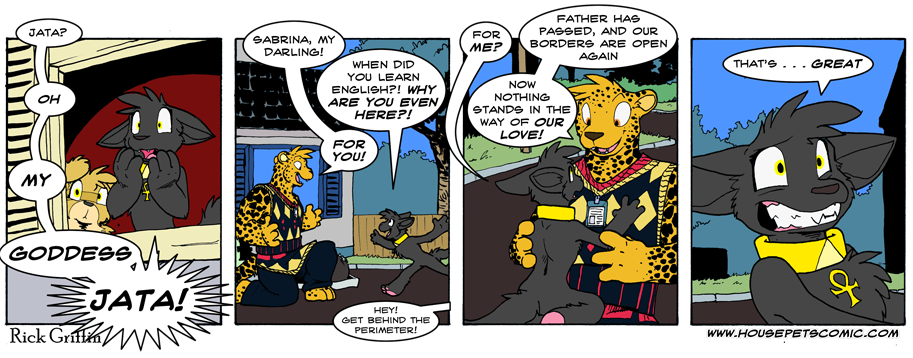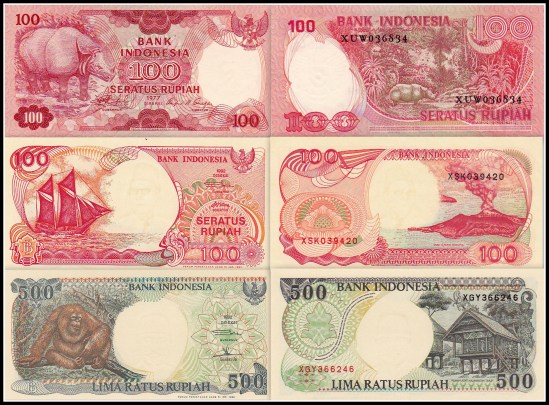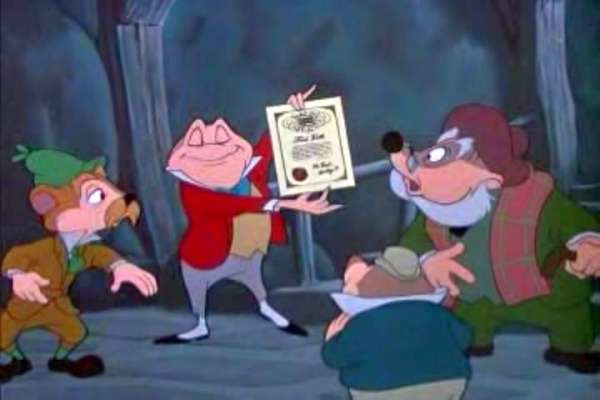Dogpatch Press
Revisiting Rainfurrest: what can we learn about limits of a growing fandom?

Everything was happy and peaceful with the furries, until… Overflowing hot tubs damaged the Rainfurrest hotel. The con’s current status is still seeking a new venue. There’s been much public discussion about bad behavior leading to this.
Separate from that drama, there was an issue about organizing their dealer’s room in 2015. High demand vs. limited capacity made pressure to compete for tables. Rainfurrest decided to manage it with a new Jury Selection process that left many feeling shut out. The same issue has happened across many cons.
For dealers, the pool is feeling crowded. For everyone else, more crowds makes more strangers with weaker links to keep peace. It’s a village vs. city situation.
Yesterday, Fred Patten’s history post profiled Rainfurrest. It summed up both issues:
RainFurrest 2015: The Dealers’ Room was booked to capacity early. Instead of putting later applicants on a waiting list as usual, the committee held a juried judging of all applicants. This resulted in some long-time dealers being rejected and some first-time dealers being accepted, which resulted in some loud complaints. There were two 2015 charity anthologies; A Menagerie of Heroes for PG-13 stories, 322 pages/fourteen donated stories, and Naughty Sexy Furry Writing: Enter at Your Own Risk for NC-17 stories, 124 pages/six donated stories. Jan did both the conbook cover and the T-shirt.
There was much unfavorable publicity from the perception that the RF committee discriminated against veteran fans in favor of promoting a “youth” atmosphere. Whether true or not, there were multiple examples of flamboyant drunken and other inappropriate public behavior from new teenage attendees, including severe hotel vandalism; enough to result in the RainFurrest’s hotel since 2011 cancelling their contract and forcing RainFurrest to find a new venue for 2016.

Fred followed up about dealer selection:
Roz Gibson posted on her LiveJournal that since several furry conventions have switched to juried acceptances of dealer’s table or artist’s alley applications, she has been rejected by all of those conventions that she has applied to. She has named RainFurrest and Biggest Little Fur Con; I don’t know which other conventions this may apply to.
I remember Roz as having a table at every convention that I went to in the past. She has done the covers for two of my books that I’m very happy with. She is also well-known for her Jack Salem character in furry comic books, so I can’t imagine the quality of her art as being a reason for her rejections. Apparently none of the conventions with juried acceptances or rejections of applicants give a reason for their approval or rejection, so Roz is wondering in print whether all of the accepted applicants today are better than her, or whether she’s been secretly blacklisted by the juried conventions for some unknown reason, or if all of these conventions have decided that she is now “too old” and doesn’t fit a “young” fannish image they are promoting.
It does raise the question of whether any other “old fan” applicants are being rejected.
Instead of the usual first-come-first-served method, we got this instead: Dealers will be selected by a committee of several senior members of the RainFurrest staff, each with years of experience in Dealers Den operations, and will make every effort toward fair and unbiased decisions to provide the best possible experience for both dealers and attendees.
Which apparently means: Our friends get first dibs, and everyone else is SOL.
Later, she followed up:
Every convention I could afford to get to switched to a ‘juried’ system and I was denied a table. So I will be at no conventions for at least a year, maybe never again, since apparently the only way to get a table is to be friends with the people running the cons, and my ability to successfully brown-nose is nonexistent.
These complaints fit with a perception of Furry Fandom being invaded by an influx of younger, party-minded youth, superficially into costume and dance and forgetful of fan history. It’s crudely expressed as fursuiters vs. writers. With less conflict, it’s in Fred’s post – A complaint: Furry fan publishing is overlooked.
But is this fair criticism? Or should we leave the kids alone?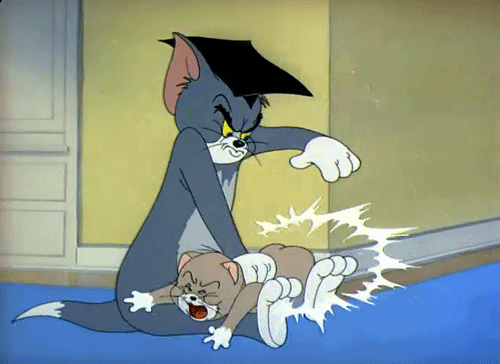
Personal thoughts
About dealer room organizing: Racing for first-come spots that instantly fill up a year ahead is awful. From what I’ve heard, this may have no “right” answer, apart from “spend more money and make room for everyone.” But there isn’t more money and room because it’s done at low costs by volunteers. So they have to filter applicants into limited space somehow. Someone will get upset or someone will get favored. But when volunteers do the job, I don’t sense a “consumer issue”. If it feels like some kind of club, it IS.
Picking for relative popularity is arguably serving fans over dealers. A random lottery could serve dealers over fans. It’s relative. On the dealer side – it may be a case of just playing that game to increase demand. On the organizer side, have integrity about selective choices. On the fan side – be aware and respectful of both the organizer’s work, and the legacy of older members.
About vandalism: I have heard many complaints of a “culture problem” with furries. I strongly favor the side that says bad behavior by a few individuals doesn’t represent the group. I would listen to reports of organizers covering it up, but haven’t heard of any such encouragement. Otherwise, it’s very easy for one person to do hit and run vandalism, without others knowing, while they unfairly take blame.
It should be clear that damage is a separate issue from rude displays of adult gear. Many selective reports conflate the two things. Rudeness exists, but it doesn’t appear to have anything to do with the venue’s economic damage complaints.
According to gossip, the venue hunting hasn’t gone as hoped in Seattle, but there are options for a smaller con in Spokane. With a previously strong fan base, it leaves the option to put on a smaller but more focused con in Spokane. Success there for more than one year can revive a welcome in Seattle.
Basically, my conclusion is “things change”. Fandom grows up and has to deal with it, and that’s a good problem to have. I see plenty of good and hopeful changes too. What do you think?
UPDATE – To be accurate, there was no hot tub overflow, it was other plumbing damage. This wasn’t meant to be a “call out” or investigation focusing on any specific group. It’s just relaying passionate discussions that came in as tips. Nepotism/discrimination would be a big concern to con organizers, so please treat all comments as subjective opinion. There’s no data that correlates young age with misbehavior, and it’s better to avoid checking incident records out of respect for data privacy. Old guard/new guard discussion is as old as fandom. I’m happy to see that this one has gotten a lot of mature and positive feedback. – Patch
CALL FOR INFORMATION: Furry Convention History, by Fred Patten.
IF YOU HAVE HELPED TO ORGANIZE A FURRY CONVENTION, PLEASE COMMENT BELOW.
Fred Patten wants to put your con in a fandom history book from an academic publisher. (See previous articles from “Furry’s favorite historian and reviewer“.) There are pieces of info lacking from many cons – Fred can make it clear what’s needed from which ones. He’ll report it like this example, the history of RAINFURREST. – Patch
Fred’s message:
For the last two years, I have been compiling a history of all furry conventions throughout the world from 1989 through the end of 2015. It has been accepted by a publisher, McFarland. It covers 112 furry conventions in North and South America, Asia, Australasia, and Europe. The manuscript is 277 pages. My deadline for finishing is March 1, 2016.
Many convention committees have given full information; others have not answered at all. Also, I am trying to get at least one illustration for each convention — art such as website logos, conbook covers, posters, illustrated membership badges, illustrated hotel room keys; whatever a committee wants to submit. McFarland says that none of the illustrations on the Internet are of high enough resolution for book publication, so I cannot just framegrab an illustration from the Internet. They need an electronic file of 300 DPI or better.
I suspect that some lack of replies are due to a committee member who is not answering or passing them on. So a public announcement might reach a committee member who wants their convention represented in my book with all questions answered.
Here is what I have on one convention.
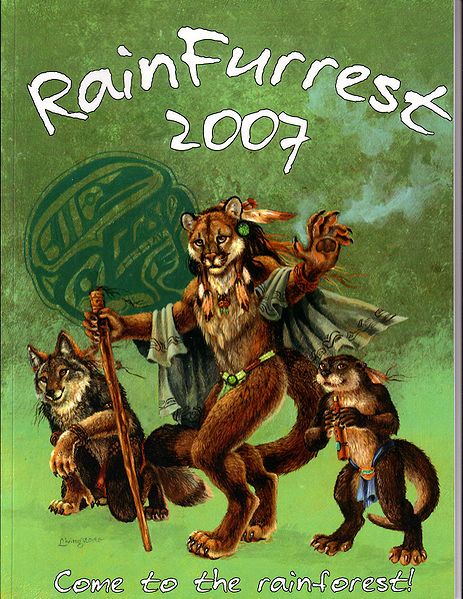
RainFurrest
RainFurrest was created to replace the Conifur Northwest by Gene Armstrong and Trap Winters in Seattle, at the same time that All Fur Fun was created in Spokane for the same purpose. RainFurrest had its act together and succeeded where All Fur Fun faded away after three years. After the first RainFurrest, it was incorporated as Rainfurrest Anthropomorphics International (RAIn). RainFurrest is known for its particularly strong furry literary emphasis, with writers’ workshops, author readings, panels featuring at least one of the furry specialty publishers, and (since 2011) an original furry anthology.
RAIn is a non-profit group which “exists primarily for the purpose of holding events to facilitate education in anthropomorphic literature, art and culture, and to facilitate the donation of funds to non-profit institutions that the board decides are worthy”. RAIn filed for 501(c)(3) status in January 2013.
Name & Date / Theme / Location / Attendance / Parade
RainFurrest 2007: August 24-26, 2007. Holiday Inn, Seattle-Sea-Tac Airport Hotel, Seattle, WA. (370/41)
RainFurrest 2008: September 26-28, 2008. “Flight.” Seattle Airport, Marriott Hotel, Seattle, WA. (599/89)
RainFurrest 2009: September 18-20, 2009. “Zombie Attack.” Seattle Airport, Marriott Hotel, Seattle, WA. (905/159)
RainFurrest 2010: September 24-26, 2010. “Furst on the Moon.” Seattle Airport, Marriott Hotel, Seattle, WA. (1,045/184)
RainFurrest 2011: September 22-25, 2011. “Furry Camping.” Hilton Seattle Airport & Conference Center, Seattle, WA. (1,420/???)
RainFurrest 2012: September 27-30, 2012. “Warehouse Furteen.” Hilton Seattle Airport & Conference Center, Seattle, WA. (1,705/???)
RainFurrest 2013: September 26-29, 2013. “Dancing in the Moonlight.” Hilton Seattle Airport & Conference Center, Seattle, WA. (2,202/???)
RainFurrest 2014: September 25-28, 2014. “Cyberpunk: Fur Meets Chrome.” Hilton Seattle Airport & Conference Center, Seattle, WA. (2,586/504)
RainFurrest 2015: September 24-27, 2015. “Swords and Sorcery.” Hilton Seattle Airport & Conference Center, Seattle, WA. (2,704/492)
Events
RainFurrest 2007: The Masquerade only had three entries. There were numerous panels and workshops, but the guest-of-honor dinner ($35) had notably poor food even by hotel poor food standards. The convention sold out the hotel by a few days before it started. The T-shirt was by Monika Livingstone. There was no theme, but one was retroactively assigned: The Rainforest.
Guests of Honor: Artist G-o-H Monika Livingstone, Fan G-o-H Dennis Avner (Stalking Cat), Writer G-o-H Phil Geusz, Musical G-o-H Alexander James Adams.
Charity: The Sarvey Wildlife Center (almost $1,000.)
Chairmen or Organizers: Gene Armstrong, Tank Winters (Trapa.)
![]() RainFurrest 2008: Registered member received airplane-style metal wings pins; brass for regular members, silver for patrons, and gold for members who were real pilots. Events included a Fursuit Masquerade, a Pet Auction, a Plushie Costume Contest, an Ice Cream Social, workshops, gaming, and dances. WerePuppy did the T-shirt. The hotel staff was reported as very friendly. This was unofficially considered “RainFurrest I”, with the previous year’s as either “RainFurrest 0” or “a beta test”.
RainFurrest 2008: Registered member received airplane-style metal wings pins; brass for regular members, silver for patrons, and gold for members who were real pilots. Events included a Fursuit Masquerade, a Pet Auction, a Plushie Costume Contest, an Ice Cream Social, workshops, gaming, and dances. WerePuppy did the T-shirt. The hotel staff was reported as very friendly. This was unofficially considered “RainFurrest I”, with the previous year’s as either “RainFurrest 0” or “a beta test”.
Guests of Honor: Mark Brill (WerePuppy) (furry artist.)
Charity: The Ferret Rescue Society ($1,000+)
Chairmen or Organizers: Tank Winters (Trapa.)
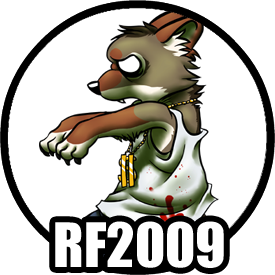 RainFurrest 2009: RainFurrest 2009 had a Dealers Den, an Art Show, a large Fursuit Lounge, a Gaming Room with a DDR tournament, a Sponsor/Patron Lounge, a three-day writers’ workshop, and many panels and other workshops. Events included a zombie game, the Fursuit Parade, the Ice Cream Social, a plushie costume contest, a Variety Show, the Guest of Honor dinner, a rant by 2, the Ranting Gryphon, a concert by Alexander James Adams, and dances with four DJs. The 42-page conbook had a wraparound color cover by Farore Nightclaw. The T-shirt was also by Farore Nightclaw.
RainFurrest 2009: RainFurrest 2009 had a Dealers Den, an Art Show, a large Fursuit Lounge, a Gaming Room with a DDR tournament, a Sponsor/Patron Lounge, a three-day writers’ workshop, and many panels and other workshops. Events included a zombie game, the Fursuit Parade, the Ice Cream Social, a plushie costume contest, a Variety Show, the Guest of Honor dinner, a rant by 2, the Ranting Gryphon, a concert by Alexander James Adams, and dances with four DJs. The 42-page conbook had a wraparound color cover by Farore Nightclaw. The T-shirt was also by Farore Nightclaw.
Guests of Honor: Farore Nightclaw (furry artist), Adam Riggs (Nicodemus, fursuiter), Special G-o-H Matthew Wayne Davis (2, the Ranting Gryphon), Alexander James Adams, Kyell Gold.
Charity: Critter Care Wildlife Society ($536.78)
Chairmen or Organizers: North.
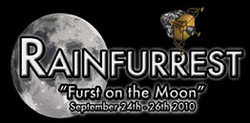 RainFurrest 2010: In 2010, RainFurrest became the sixth convention to surpass 1,000 attendees. The “Furst on the Moon” theme was emphasized in a program throughout the convention of landing a fur on the Moon and returning him or her safely to fandom. The fur was revealed by Dr. Werner von Wolfenstein to be a Cosmofur Siberian Husky of the Sovipaw Air Force. In addition to the Charity Auction, there were tip jars in the con store with the faces of con staffers Gene, Aloha, North, and Trapa. All donations went to the charity, and the jar getting the most donations got its staffer hit in the face with a pie by the volunteer who worked the most during the con. Other events included a plushie costume contest, a Second Life social, a live model workshop, a furry high tea, and a Graveyard Greg book celebration with his first novel. DragonDyne Publishing launched its new game, Neverwhen. Kyell Gold held a writing workshop. The T-shirt was by Balto.
RainFurrest 2010: In 2010, RainFurrest became the sixth convention to surpass 1,000 attendees. The “Furst on the Moon” theme was emphasized in a program throughout the convention of landing a fur on the Moon and returning him or her safely to fandom. The fur was revealed by Dr. Werner von Wolfenstein to be a Cosmofur Siberian Husky of the Sovipaw Air Force. In addition to the Charity Auction, there were tip jars in the con store with the faces of con staffers Gene, Aloha, North, and Trapa. All donations went to the charity, and the jar getting the most donations got its staffer hit in the face with a pie by the volunteer who worked the most during the con. Other events included a plushie costume contest, a Second Life social, a live model workshop, a furry high tea, and a Graveyard Greg book celebration with his first novel. DragonDyne Publishing launched its new game, Neverwhen. Kyell Gold held a writing workshop. The T-shirt was by Balto.
Guests of Honor: Artist G-o-H Albert C. Peña (Balto), Fursuiter G-o-H Kodi, Writer G-o-H Graveyard Greg.
Charity: Northwest Wildlife Rehabilitation Center ($3,000+)
Chairmen or Organizers: North.
RainFurrest 2011: RainFurrest’s first annual charity anthology went on sale: Stories of Camp RainFurrest, printed by FurPlanet Productions; a 108-page trade paperback with 11 donated short stories for $10.00 with all proceeds donated to that year’s charity. TaniDaReal drew both the conbook cover and the T-shirt.
Guests of Honor: Artist G-o-H Tanja Freese (TaniDaReal), Writing G-o-H Alan Dean Foster, Fursuit G-o-H Deanna Larsson (Beetlecat), Artist Special Guest Astolpho.
Charity: Love A Mutt Pet Rescue.
Chairmen or Organizers: Loial.

RainFurrest 2012: The presentation of the first (2012) ALAA Hall of Fame honorees, to those characters, people, books, or films that helped to mold furry fandom, was announced: Bugs Bunny; Walt Disney; and the novel Watership Down by Richard Adams. RainFurrest’s second annual charity anthology wasTails of a Clockwork World, 119 pages/eight donated stories with all sales going to the charity. YamiBliss drew both the conbook cover and the T-shirt.
Guests of Honor: Artist G-o-H Jeffrey Camion (YamiBliss), Writing G-o-H Elizabeth Ann Scarborough, Fursuit G-o-H Sara Howard (Matrices).
Charity: Rabbit Meadows Sanctuary & Adoption Center.
Chairmen or Organizers: Gene Armstrong.
RainFurrest 2013: RainFurrest’s third annual charity anthology was Dancing in the Moonlight, 77 pages/five donated stories with all sales going to the charity. Soulscape drew both the conbook cover and the T-shirt.
Guests of Honor: Artist G-o-H Thea Reven (Soulscape), Fursuit G-o-H Temperance, Writing G-o-H FurPlanet Productions, Fandom G-o-H Fred Patten (in absentia), Writing Special Guest Phil Geusz.
Charity: The Clouded Leopard Project ($6,454.17)
Chairmen or Organizers: Aloha.
RainFurrest 2014: The presentation of the third (2014) ALAA Hall of Fame honorees, to those characters, people, books, or films that helped to mold furry fandom, was announced: Carl Barks; the novel Charlotte’s Web by E. B. White; and Osamu Tezuka. RainFurrest’s fourth annual charity anthology wasFurtual Horizons;A Rainfurrest Anthology, 264 pages/eleven donated stories with all sales going to the charity. The 48-page wraparound Program Book cover was by Egypt Urnash, who also did the T-shirt.
Guests of Honor: Writing G-o-H Kyell Gold, Artist G-o-H Margaret Trauth (Egypt Urnash), Music G-o-H Jared Clark (Pepper Coyote), Fursuit G-o-H Croc.
Charity: Cougar Mountain Zoological Park ($7,000)
Chairmen or Organizers: Cerb.

RainFurrest 2015: The Dealers’ Room was booked to capacity early. Instead of putting later applicants on a waiting list as usual, the committee held a juried judging of all applicants. This resulted in some long-time dealers being rejected and some first-time dealers being accepted, which resulted in some loud complaints. There were two 2015 charity anthologies; A Menagerie of Heroes for PG-13 stories, 322 pages/fourteen donated stories, and Naughty Sexy Furry Writing: Enter at Your Own Risk for NC-17 stories, 124 pages/six donated stories. Jan did both the conbook cover and the T-shirt.
There was much unfavorable publicity from the perception that the RF committee discriminated against veteran fans in favor of promoting a “youth” atmosphere. Whether true or not, there were multiple examples of flamboyant drunken and other inappropriate public behavior from new teenage attendees, including severe vandalism; enough to result in the RainFurrest’s hotel since 2011 cancelling their contract and forcing RainFurrest to find a new venue for 2016.
Guests of Honor: Artist G-o-H Jan, Writing G-o-H Renee Carter Hall (Poetigress), Fursuit G-o-H RedHyena.
Charity: Cougar Mountain Zoological Park ($10,000+)
Chairmen or Organizers: Rex Wolf.
[Questions:]What were the 2011, 2012, and 2013 Fursuit Parade totals?
What were the 2011 and 2012 charity donations?
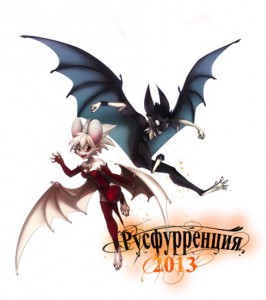 I have most general information for many cons. What I still need is specifics for many cons – such as the Central Midwest Fur Meet 2012 attendance; the Fursuit Parade totals at EuroFurence 17, 19, 20, and 21; the FurFright Fursuit Parade totals for 2009, 2010, and 2011, and the amount of the FurFright 2013 charity donation.
I have most general information for many cons. What I still need is specifics for many cons – such as the Central Midwest Fur Meet 2012 attendance; the Fursuit Parade totals at EuroFurence 17, 19, 20, and 21; the FurFright Fursuit Parade totals for 2009, 2010, and 2011, and the amount of the FurFright 2013 charity donation.
I need illustrations for many cons. Here are the Abando (Brazil) logo and the RusFURrence 2013 (Russia) T-shirt.
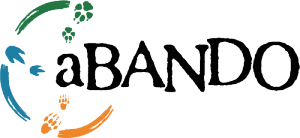
I can send the questions that I have about any convention to anyone who asks.
Best wishes;
Fred
FurNightATX is coming to Austin! Organizer Haven gives a Q&A for the Furclub Survey.
 Furclubbing: “A repeat/regular nightclub event by furries for furries.” It’s a New Thing that’s been spreading since the late 2000’s. This kind of dance party is independent from cons. This builds on the growth of cons, and takes things farther.
Furclubbing: “A repeat/regular nightclub event by furries for furries.” It’s a New Thing that’s been spreading since the late 2000’s. This kind of dance party is independent from cons. This builds on the growth of cons, and takes things farther.
It’s more ambitious than events that happen once, house parties, or informal meets. Those can stay inner-focused for friends who already know each other. This brings partnership with venues that aren’t hotels, and new supportive interest in the kind of events they host. It crosses a line to public space. A stranger may walk in off the street to discover their new favorite thing. It encourages new blood, and crossover to other scenes. It makes subculture thrive. It’s a movement!
See the list of parties at The Furclub survey. Any party that gives a Q&A will get a featured article.
Featured here is FurNightATX, a new event focused towards the Furry Fandom in Austin Texas. It was shared by MC/organizer Haven, with extra-professional outreach (I love publicizing tips that come that way). I asked if FurNightATX was affiliated with the irregular Austin Furry Dance series organized by Whines – they’re friendly but the events aren’t connected. That’s an interesting sign of independent activity. Haven shares more:
FurNightATX (2016) ____________________
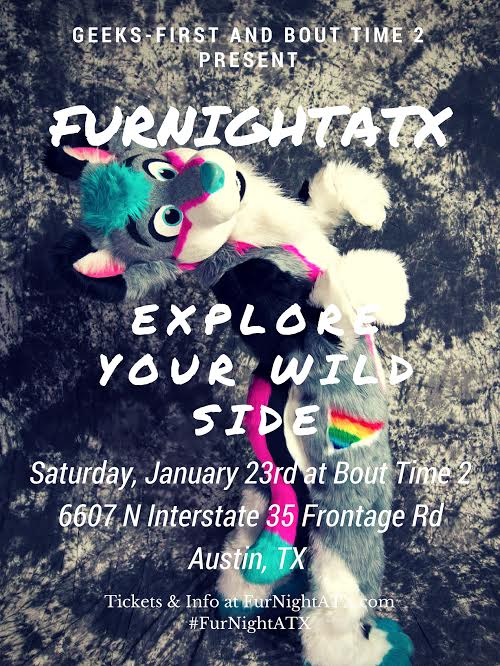
- Website: www.furnightatx.com
- Facebook: https://www.facebook.com/FurNightATX
- Twitter: @furnightatx and @havenfusky
Who:
Haven T. Fusky is founder and MC. Edgewise Gryphon is the DJ, we’ll also have guest performers at different events. @DarrohHuskers is our first guest DJ. Check his MFF set.
What:
It is a club event that will feature a variety show, guest performers and DJs. There is a $5-$10 suggested donation with 50% of all donations going to a local animal organization.
When:
Our first event is January 23rd, 2016. After that we hope to have it monthly.
Where:
It will be held at Bout Time 2 in Austin Texas. There are restaurants and hotels located in the direct vicinity for those wishing to travel in. It is our hope to get all Texas furs in for a fun night here in Austin.
How it’s organized:
Haven has been working behind the scenes on other events (namely an LGBT Focused geek/gaming convention called HavenCon). Several fur friends had expressed an interest in a club night. So, Haven sat down and started working on it!
(HavenCon is a larger happening with “3 days of gaming and geek activities” – see him featured as the con’s mascot on the flyer.)
Vibe:
We will definitely know this better after our first event. But it should be friendly and open. It is a 21+ event so we’re free to explore things. There should be a good mix of suiters and non-suiters alike!
Promotion:
Promotion right now mainly consists of word of mouth and some FB advertising. Please visit our website and follow us on social media.
Reactions so far:
The venue, BT2 is very excited to have us. Haven spent some time there bouncing around and talking with people and then dancing. Everyone had a great time interacting with him and so when we came up with the idea they agreed almost immediately.
Business details:
Costs are minimal at this time, but as we grow and look to bring in more outside entertainment that may change. We will be looking into merchandise to sale to help support the event as well as the local animal organizations.
Good story about attending? Video or pics? (Not yet, but I’m excited to see them when they happen!)

Fledger by Nicholas Barrett, Book Review by Fred Patten
Submitted by Fred Patten, Furry’s favorite historian and reviewer.
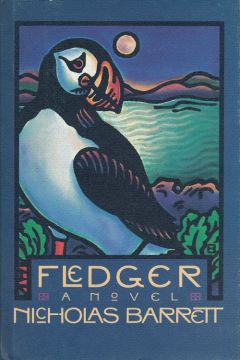 Fledger: a Novel, by Nicholas Barrett.
Fledger: a Novel, by Nicholas Barrett.
NYC, Macmillan Publishing Co., September 1985, hardcover $13.95 (207 pages).
Ever since Adams’ Watership Down was published in 1972, just about any “realistic” nature fantasy centered upon one particular species has been “high profiled” as a “Watership Down for” (whatever species is featured). Fledger is certainly a Watership Down for puffins.
A flock of puffins is returning to Land (specifically a bleak, rocky shoreline) to dig burrows and lay eggs after three years of living at sea upon ice floes. Rock Samphire, a hen, is distraught and insulted because her mate, Sorrel, will not listen seriously to her dreams of impending disaster if they continue to build their rookery as puffins always have; on the Land and upon a small island just offshore. Ringleader, the flock leader, dismisses her dreams because the Golden Lord only sends true dreams to flock leaders like himself, and he has not had any nightmares. Rock Samphire stops protesting, but she builds a secret burrow for her egg on the other side of the island, apart from the other puffins. This just removes her from their protection, and she is eaten by the swaabies (great black-backed seagulls) just after laying their egg. Ringleader orders Sorrel to raise the chick, Goldie (Golden Samphire), in secrecy.
Goldie is predisposed from birth to believe in the puffins’ doctrine as revealed by Ringleader:
“‘And you must be Ringleader, sir,’ chirped the little bird. [No, it’s Sandpiper.] ‘And you have come to give me the Faith that I shall need to leave this strange burrow on the day when the Golden Lord calls me and the other fledger puffins down to the sea together to swim away from the Land.” (p. 33)
Goldie is informed that Ringleader has been crippled by swaabies. “The little chick looked from one of them to the other, dismayed: ‘Where am I going to get my Faith now?’ he pleaded. Both older birds ignored him.” (ibid.)
Goldie is already separate from the other fledgers, and he is left completely alone when his father disappears; whether eaten by swaabies or “answering instead, perhaps, the Lord’s call back to the open sea along with all the other flockers.” (p. 38) Goldie is sure that the Lord is punishing him for something or other:
“‘Please don’t be angry with me, Lord,’ called Goldie, as he cowered in his cave. ‘I am trying to have Faith in You – but nobody taught me how: You called my father back to the open sea before he could tell me any of the things I needed to know.’” (p. 39)
A lightning strike from the almost-permanent storm clouds above collapses a rock column across the strait, connecting Puffin Island to the Land. This is interpreted by Goldie as a sign from the Lord that he should leave his burrow and join the other fledgers at sea. But after an unsatisfactory encounter with an atheistic seal, Goldie is horrified to discover that all the other puffin fledgers have been eaten that morning before they could take to the sea, by a horde of rats who have overrun the puffins’ burrows. Only the crippled Ringleader is left, humiliated by Hemlock’s sadistic rats. Ringleader orders Goldie to escape to sea and warn the flockers not to return, but before he can, he is captured by the rats.
“Although Goldie had never seen a rat before, he was in no doubt that he was looking at one now. The creature was nearly twice his size and sat foursquare in front of him on plump pink haunches as, with equally pink and pudgy forepaws, it dusted the gritty soil from its matted orange-brown coat. Brown eyes looked nervously at him from the sharp pointed face, displaying what might have passed for gentleness had the creature not suddenly revealed rows of sharp yellow teeth when it opened its mouth to speak.” (p. 57)
Goldie is sentenced to fight to the death with the rats’ champion, Bubo. But before the fight can take place, he is rescued by Hellebore, a rattess belonging to the faction of Mezereon, the pack leader back on the Land. Briefly, the rat pack is divided into two factions, the legitimists led by Mezereon and the young rebels led by Hemlock and Bubo. Hemlock’s gang has taken over Puffin Island despite Mezereon’s order against doing so, and his rats are waiting for the adult puffins to return so he can kill or enslave them. Mezereon’s plan is to help Goldie to escape to sea (after the fight) and warn the fledgers against returning. This is Goldie’s plan, but now he would be doing it on Mezereon’s terms.
The jacket blurb says, “And when marauders invade the island, it is Goldie, who through heroic acts of bravery and perseverance, must rescue his fellow puffins from destruction.” Fledger is actually more complex then that. The novel splits to follow four factions, each involving treachery or self-interest: Hemlock’s, Bubo’s, and the rats on Puffin Island’s; Mezereon’s, Hellebore’s, and the rats on the Land; Goldie’s and the puffins at sea who want to rescue Ringleader; and their leader, Sandpiper, with the puffins who don’t want to rescue Ringleader.
Goldie eventually becomes strong enough that, when Sandpiper refuses to let any puffins go to Ringleader’s aid, he and two other daring young puffins, Carrageen and Purslane, organize a clandestine rescue mission and a plot to turn the rat factions against each other:
“‘Help comes to those who help themselves,’ said Goldie briskly [to Ringleader]. ‘That’s one thing I learned from the rats. If the Lord had wanted your life, He would have taken it by now, and if He had permitted the Life Forces to abandon you, then you would not have been able to squeeze through that hole back there with your damaged wing – because you were prepared to withstand great pain to climb through.’” (pgs. 169-170)
Goldie never stops being a bit holier-than-thou. But he matures from a timid fledger who constantly cries for Divine guidance to a confident adult who tempers his faith with self-reliance:
“As he sneaked past the last burrow on the landward fringe of the colony, Goldie allowed himself a sigh, and offered up silent thanks to the Golden Lord for his safe delivery past the rat holes.” (p. 172)
On the other hand, maybe Goldie’s faith in the Golden Lord is an attempt to copy the rabbits’ devotion to Frith. Fledger is, above all, a Watership Down for puffins.
Fledger is advertised as A Book For All Ages. Instead, it seems to be a Young Adult novel hoping that it will be mistaken for an adult book. The dust jacket is by Anne Bascove, an artist whose paintings have had many exhibitions in America and in Europe.
Housepets! Will Do It For Free (Book 6), By Rick Griffin, Book Review By Fred Patten
Submitted by Fred Patten, Furry’s favorite historian and reviewer.
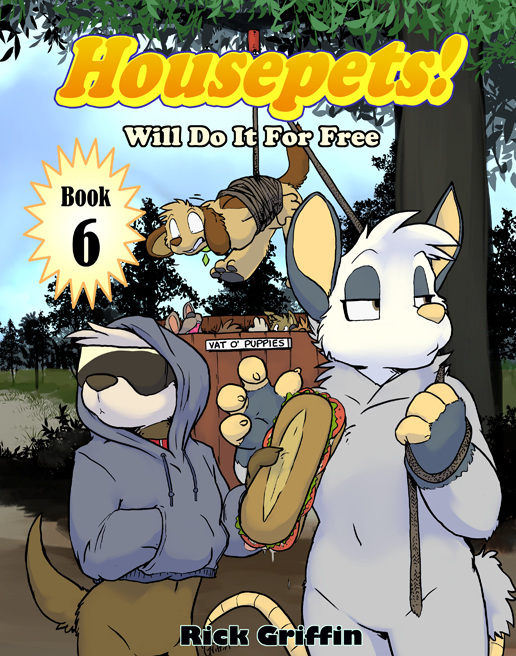 Housepets! Will Do It For Free (Book 6), by Rick Griffin.
Housepets! Will Do It For Free (Book 6), by Rick Griffin.
North Charleston, SC, CreateSpace, November 2015, trade paperback $13.95 (52 pages).
Another year passes, and here is the new annual collection of the Housepets! online comic strip by Rick Griffin. Housepets! has appeared each Monday-Wednesday-Friday since June 2, 2008. It has won the Ursa Major Award for the Best Anthropomorphic Comic Strip for every year since! – for 2009, 2010, 2011, 2012, 2013, and 2014. Umpty million thousand furry fans can’t be wrong.
Book 6 contains the strips from June 19, 2013 to May 30, 2014; story arcs #70, “Mice To Meet You” to #77, “Heaven’s Not Enough, part 1”, plus the one-off gag strips before and between these.
Housepets! is the story of the dogs, cats, ferrets, rabbits, and other pets of Babylon Gardens, a typical residential suburban neighborhood – in an alternate universe. The animals are larger than in our universe (but not human-sized), can talk, are usually bipedal, and address their human owners as “Mom” and “Dad”. Their status is somewhere between pets and children. Points established over the years are that humans can bequeath their belongings to their pets, who do not need a human guardian; human storekeepers are not allowed to sell catnip to cats; human police forces have an auxiliary of Police Dogs who are not all police dogs; the pets comment sardonically on how they can go naked in public but their human “parents” can’t; and – lots of other stuff.
When Housepets! began, the main characters were the dog Peanut Butter and the Cat Grape Jelly, both belonging to Mr. and Mrs. Earl Sandwich of Babylon Gardens. By now the strip has built up such a large cast of pets – Tarot, Tiger, King, Bailey, and many more dogs (dogs), Maxwell, Sabrina, and all the Mr. Bigglesworths (cats), Keene, Duke, Rock, and the other Milton ferrets (ferrets), Zach (rabbit), and nonpet woodland critters – Karishad (fox), Jessica (opossum), Miles, Lucretia, Daryl, the other Daryl, and the rest of the pack (wolves), Falstaff, Truck, and Custom Ink (raccoons), Spo and Squeak (mice) – well, Peanut and Grape have pretty much faded into the background.
In Book 6, Squeak demonstrates why she likes bigger cats and dogs. The Gallifrax Dimension turns the bipedal Peanut, Grape, Tarot, and Max into four-legged cats & dogs. Peanut continues to write/draw his “Spot (Superdog)” comic book. Rick Griffin wants to draw anthro kangaroos at the Babylon Gardens Zoo. Prince Jata (leopard) arrives from the African micronation of Feraga to marry Sabrina, and Fido the police dog declares his love for her. (A dog in love with a cat — §gasp§). Jata and Fido duel for her hand. Jessica the opossum risks freezing in winter snowdrifts to save the life of Tiny Tum (raccoon child) at Openermastime. The wolves’ lupine sense of humor is not appreciated by humans. Peanut, Grape & friends imaginate Agatha Christie’s And Then There Were None. The demigods present Valentine’s Day. Itsuki the tanuki exchange student from Japan only appears in one strip this year. The wolves tell stories. “Tiger’s [dog] Very Own Super Special Television Show!” (He’s upstaged by Chauncey, the Robot Penguin.) Book 6 concludes with “Heaven’s Not Enough, part 1”, in which Pete the demigod griffin appears to both King and his wife Bailey (dogs), turns King from a Corgi back into a human (Pete claims that his original transformation spell just expired), Bailey agrees to become Pete’s avatar in Heavenly battle to save King, and Cerberus the giant three-headed dog (another demigod) sends everyone to Heaven to see how things work out. Part 1 is complete, but ends on a cliffhanger. This is the first Housepets! collection that ends on a cliffhanger rather than a story arc’s conclusion.
Book 6 presents four rows of strips to a page in full color, with some brand-new illustrations to make story sequences come out evenly. Like all long-running comic strips, this assumes that the reader is familiar with the characters and their backstories. Fans of Housepets! should certainly get Book 6; reading it is much easier than reading the cartoon strip-by-strip on its website’s archive. For those who are not already fans, it’s recommended that you start with one of the earlier volumes to get familiar with the cast: Book 1, Housepets! Are Naked All The Time; Book 2, Housepets! Hope They Don’t Get Eaten; Book 3, Housepets! Can Be Real Ladykillers; Book 4, Housepets! Are Gonna Sniff Everybody; and Book 5, Housepets! Don’t Criticize Your Lovelife. They’re all great, and they’re all still available on Amazon.com.
– by Fred Patten
Ninja Timmy, By Henrik Tamm – Book Review By Fred Patten
Submitted by Fred Patten, Furry’s favorite historian and reviewer.
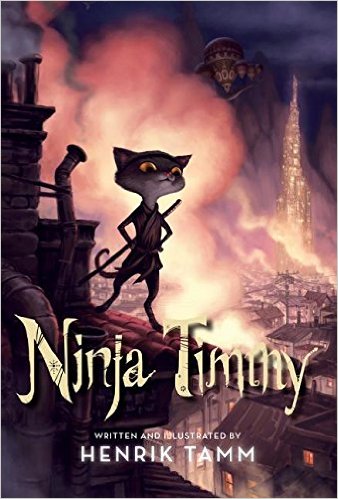 Ninja Timmy, by Henrik Tamm. Illustrated by the author.
Ninja Timmy, by Henrik Tamm. Illustrated by the author.
NYC, Delacorte Press, November 2015, hardcover $14.99 (211 [+ 2] pages), Kindle $9.99.
This children’s book was originally published in 2013 in Sweden as Ninja Timmy Och De Stulna Skratten, although it was written in English. Henrik Tamm is described in an About the Author as “a conceptual designer in Hollywood involved in various animated and live-action projects” (p. [213]), including the Shrek and Chronicles of Narnia movie series.
This children’s book for 8- to 12-year-olds (grades 3 to 7) is technically too young for furry adult readers. But, like many CGI animated features, it will be of interest due to the setting (a Medievalish European metropolis inhabited by anthropomorphic animals and humans together), the full-color illustrations on almost every double-page spread, and the plot of natural and magical evil and the young animals who fight it.
The visual richness is evident from the moment of opening the book. The front double-page endpapers show a panorama of the city of Elyzandrium busy at midday, with high towers and dirigibles and ascension balloons overhead. The rear endpapers show the same scene but at night, dark blue and with empty streets, but with the city’s windows all alight.
Timmy the cat (“[…] not quite fully grown yet, but definitely not a kitten”), Simon the mink, and the pig brothers Jasper and Casper are four teenage friends in Elyzandrium:
“It was a warm afternoon. Through the open window they could see the bustle of the city below. Elyzandrium was its name, and it was sprawled across a valley and enclosed on all sides by high, forested mountains. Fantastical three-hundred-foot bamboo towers soared into the sky, and smoke billowed from ten thousand chimneys on buildings between them. A million vehicles of all kinds clogged the dusty streets, and the sky buzzed with steam-powered balloons and other strange-looking flying machines.” (p. 3)
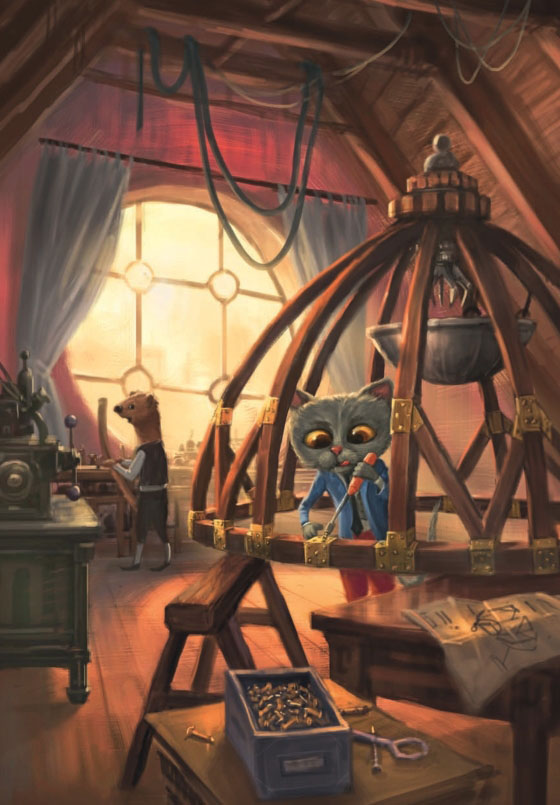 They are orphans who escaped from the city’s orphanage and have become amateur inventors, peddling their tinkerings for food, lodgings, and the junk that they build their clever devices from. But they are tired of being robbed by older gangs like the brutal Gribble wild boar cousins, and accused of being “probably criminals” themselves by the equally-brutal city guards if they complain. Timmy is about to be arrested after one such incident when he is rescued by Alfred, an elderly human inventor whose clockwork devices are at least partly magical. Alfred has become quietly dismayed by Elyzandrium’s gradual decent over the decades into legal and illegal lawlessness, and he puts his expertise to the help of Timmy and his friends’ determination to fight back against the gangs, in secrecy as ninjas.
They are orphans who escaped from the city’s orphanage and have become amateur inventors, peddling their tinkerings for food, lodgings, and the junk that they build their clever devices from. But they are tired of being robbed by older gangs like the brutal Gribble wild boar cousins, and accused of being “probably criminals” themselves by the equally-brutal city guards if they complain. Timmy is about to be arrested after one such incident when he is rescued by Alfred, an elderly human inventor whose clockwork devices are at least partly magical. Alfred has become quietly dismayed by Elyzandrium’s gradual decent over the decades into legal and illegal lawlessness, and he puts his expertise to the help of Timmy and his friends’ determination to fight back against the gangs, in secrecy as ninjas.
They are just in time, because something or somebody (revealed to the reader as the Rabbit, a tall, bright blue rabbit with fiery eyes; a wizard) has been robbing the city’s animal and human children of their laughter. The Rabbit is also the secret sponsor of the Gribbles.
I enjoyed the problem that Timmy & friends have at first in persuading anyone that they are good ninjas. Traditional ninja (no s) do not have a good reputation – that’s why all the first Japanese movies shown in America always tried to turn the ninja into samurai – and I’m glad that this book doesn’t whitewash them any more than necessary. This scene in Ninja Timmy does introduce The Girl, Flores, a tabby catgirl:
“The girl hopped out of the cockpit and took off her goggles. As she did so, Timmy was overwhelmed. This scowling cat was the toughest and coolest and most beautiful cat girl he had ever seen. Simon noticed it too, and struck a pose, about to pour on his usual charm. But Timmy wanted to be the one she talked to, and he quickly continued.” (p. 68)
 Timmy has a girlfriend! He hopes. Actually, Timmy is still young enough that he doesn’t know what to do with a girlfriend. Simon, who is slightly more experienced, gives him older-brotherly advice.
Timmy has a girlfriend! He hopes. Actually, Timmy is still young enough that he doesn’t know what to do with a girlfriend. Simon, who is slightly more experienced, gives him older-brotherly advice.
Meanwhile, the four foil the Gribbles’ nighttime attempt to kidnap an infant puppy. This brings them plus Flores to connect the Gribbles to the loss of Elyzandrium’s children’s laughter. Unfortunately, it also brings them to the Rabbit’s attention. He decides that he can use Flores in his plans. Timmy? Kill him. But the Gribble cousins seem too amateurish and clumsy. The blue Rabbit sends the more efficient Gack the iguana and his Iguana motorcyclist gang (steam-powered bikers) to kidnap Flores.
The climax is the animal heroes’ breaking into the Rabbit’s lair to rescue Flores and all of the children’s stolen laughter. It would be a spoiler to reveal what the Rabbit wants the laughter for, but it makes the Rabbit a more pathetic than evil creature. Let’s just say that the book ends with Timmy and his friends victorious and ready for new adventures – and one is presented to them.
Ninja Timmy is a light trifle for adult readers, but it would make a great outline for a CGI animated movie for the family. Furry readers will appreciate the steampunk city of anthropomorphic animals and humans living peacefully together. Most furry fans are still too young to become parents, but when they do have children, this will become a good book to remember.
– by Fred Patten
Furry Christmas and Yappy New Year!
Hugs for everyone and stay fluffy. Dogpatch Press will be back after a short break for holidays.

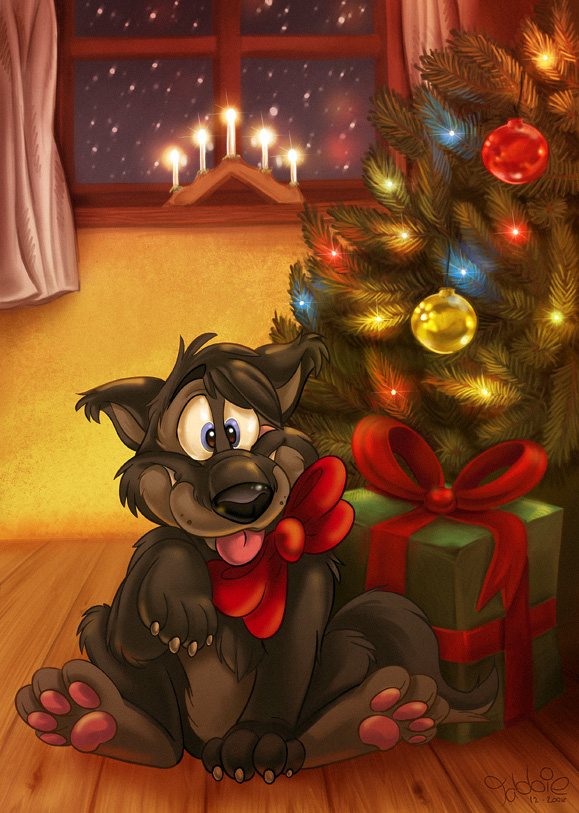

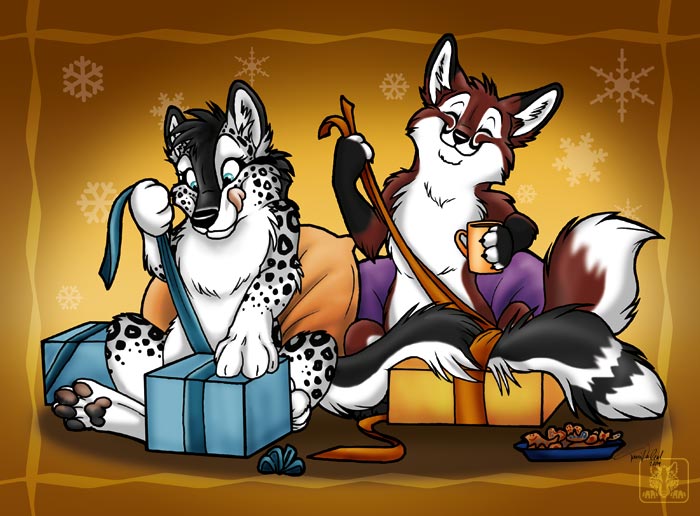
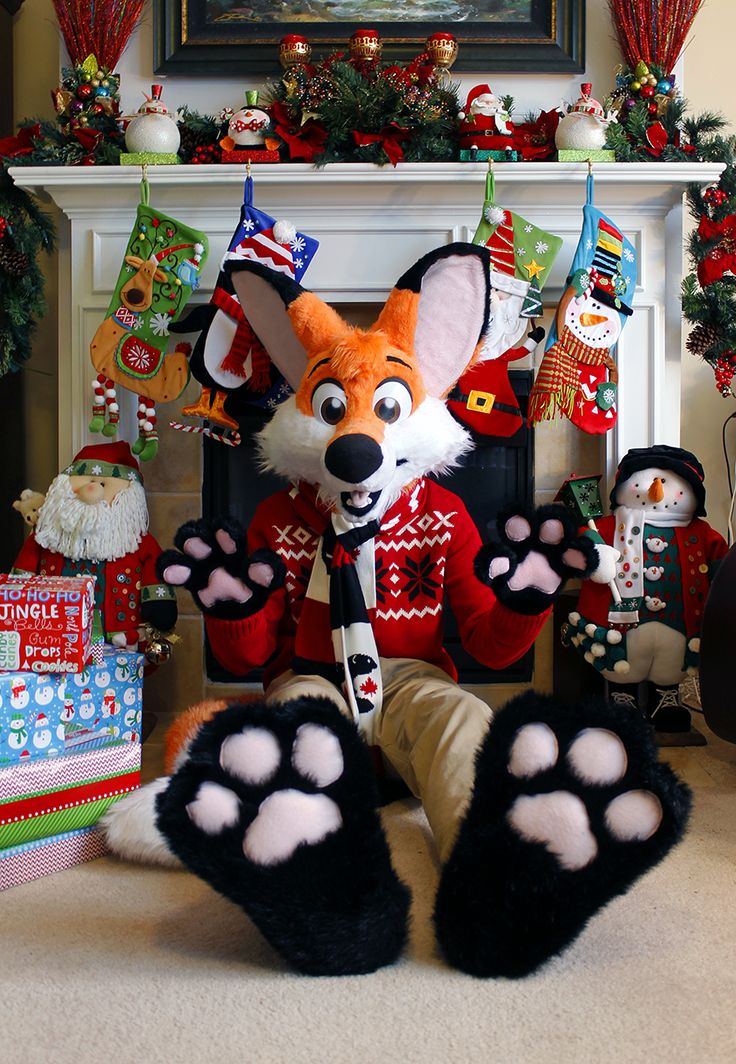
When you try to open your Christmas presents early w/ @tallfuzzball 
GeneStorm Book 2, Fort Dandelion, by Paul Kidd – Book review by Fred Patten.
Submitted by Fred Patten, Furry’s favorite historian and reviewer.
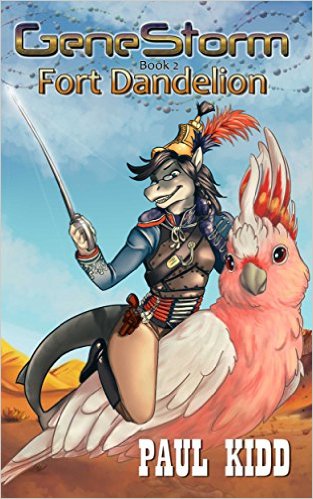 GeneStorm. Book 2, Fort Dandelion, by Paul Kidd
GeneStorm. Book 2, Fort Dandelion, by Paul Kidd
Raleigh, NC, Lulu.com/Perth, Western Australia, Kitsune Press, 11/2015, trade PB $23.11 (347 pages), Kindle $7.95.
Gene Storm: Fort Dandelion follows closely after Book 1, City in the Sky. It is also “set in the Australian ‘weird-lands’ 150 years after the GeneStorm plague has transformed the world entirely. Everyone is a mutated hybrid. The protagonist is Snapper, a female half-human, half-shark. She rides a giant cocatoo,” as I said about Book 1. See the cover, unsigned but presumably also by Kalahari. Or this from the first page:
“Jemima Haversham Greyfin – known to all and sundry as ‘Snapper’ – pushed back her helmet and gazed lovingly off towards the south, towards the far off ruins. She patted the neck of her great pink riding cocatoo and dragged in a breath, savouring the rich, alien scents in the air.” (p, 5)
Other major characters include Kitterpokie, a female giant mantis with four arms (two with hands, two with pincers); Beau, a fox/golden pheasant hybrid; Throckmorton, a conglomeration of green, leafy flying plants with three pairs of wings, plus vines with heads that resemble pink and orange flowers and that carry a notebook, a crossbow, and a squeeze-powered air horn; and Sparkle, a massive crocodile/wild boar/rat hybrid. I could fill this review just describing all the minor characters, many of which have to be imagined to be believed.
Snapper and the first four are residents of Spark Town, a Wild West-type settlement isolated in a deep valley, somewhere in what was Australia before the collapse of civilization in the GeneStorm that mutated everyone into a hybrid of human and god-knows-what – no two alike — 150 years before. This was several hundred years in our future, as is obvious by the ruins of giant holograms, fusion reactors, aerodynes, and the like. Spark Town and the villages around it have been cut off from the rest of the world by the mountainous walls of the valley plus swaths of deadly radiation, until the events in City in the Sky.
Kidd has a talent for setting colorful scenes:
“At night, the streets of Spark Town were gorgeous to behold. Coloured lights were strung gaily along the streets, winding up into green trees. Little blue cat-birds nestled in the branches, each a chirping ball of fluff. The creatures twittered sleepily, watching as late night traffic walked through the streets below.
The roads were velvety soft sand, all shaded by plant-animals and trees. Walking back home from the ‘Dancing Dugite’ at midnight, Snapper strolled arm in arm with Kitterpokie, breathing in the scents of range dust and flowers on the sharp night air. Toby towed Throckmorton along on the end of a line – the floating plant had perhaps had just a tad too much to drink, and was all but asleep in mid air. […]” (p. 58)
As Book 2 begins, Snapper has been leading a small exploration party from Spark Town out of the valley for the first time since the GeneStorm. She, Kitterpokie, and the others find dangerous mutants, the ruins of a vast city, and lots of valuable relics to salvage. After two chapters of adventures, they return to Spark Town to report. The town council decides to send out a larger exploration party with Snapper in command, and to establish a permanent fort outside the valley to protect cautious colonists.
The last half of Fort Dandelion is the adventures that Snapper and her expedition have.
“Raymond and Snapper rode in beneath the great arched doorway. The bank’s main hall showed heavy damage from blaster fire: furniture had been shot to pieces, and a long counter fronted with clear glass had been all but blown apart. […]
The vaults had once contained hundreds of locked drawers. The bulk of these had been smashed open, and the trays inside hurtled all about the room. Here and there, a few strange items still remained, forgotten on the floor: shattered computer memory sticks, and heaps of mildewed plastic sheets covered in dense typing. A pile of bones lay over in one corner. A human skeleton, missing a large proportion of its head. It did, however, still have a blue suit of some sort of tough material, and a pistol lying near its hand. The plant [Throckmorton] drifted down and looked everything over, appropriating the silver pistol, a spare battery and a red ID chip that lay in the dust.
Kitterpokie and her budgerigar peeked into the vault.
‘Oooh — have we anything useful? Gold? Silver?’ Industrial metals were always welcome: silver was extremely handy for making percussion caps. ‘Ah. We seem to have arrived rather late to the party.’
‘Here is a gun-thing! It is nice and shiny!’ Throckmorton held up the pistol and examined it with great care. ‘Will it explode?’” (pgs. 134-135)
A character description continued from the above:
“The blue protective suit was delightfully stretchy, but the pants had been made for human legs: Beau’s lower extremities were rather more avian in shape. The upper garment fitted well, and the blue looked extremely handsome against the man’s golden feathers and orange fur.” (p. 137)
The GeneStormers are more than just weird-looking people. Their mutant attributes such as Snapper’s shark electrical-detection sense are used. Here is Beth, a rhinoceros woman:
“Beth and the rancher were each breaking furniture over one another’s skulls. They swirled about the balcony knocking over tables. The rancher managed to grab Beth’s horn and jam it into a wooden pillar. As the rhino struggled to free herself, the rancher gave her an almighty kick in the rear.” (p. 55)
The explorers find fascinating shattered futuristic ruins, insanely savage mutants, eerie mysteries, desperate battles, welcome and unwelcome surprises – but the deadliest threat comes from within their own party.
GeneStorm: Fort Dandelion is well worth reading for its exotic descriptions, its humor, and its action. Yes, it’s based on Kidd’s own GeneStorm Role Playing Game, but the fan who sniffed that he’d never waste his time reading a novel hacked out as a commercial spinoff of a role playing game is missing out on a very imaginative and enjoyable book.
– by Fred Patten
Typewriter Emergencies, Edited By Weasel – Book Review By Fred Patten
Submitted by Fred Patten, Furry’s favorite historian and reviewer.
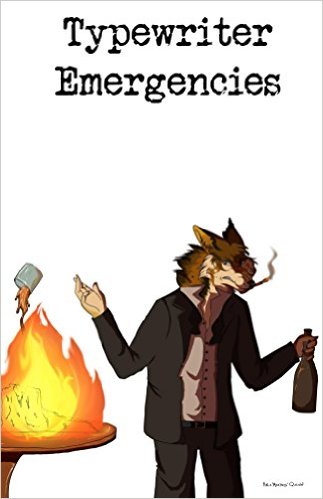 Typewriter Emergencies, 2015 Edition [edited by Weasel]
Typewriter Emergencies, 2015 Edition [edited by Weasel]
Manvel, TX, Weasel Press, October 2015, trade paperback $16.95 (179 pages), Kindle $3.99.
The blurb says, “Welcome to the first release of Typewriter Emergencies, a collection of psychologically damaging and hard hitting furry literature.” The implication is that this is the first of an ongoing series of furry stories that the blurb goes on to describe as “gut-wrenching”. “Weasel Press is proud to have our first furry collection on the books and we hope you will enjoy every moment this intense anthology has to offer.”
The 13 stories, with a cover by Kala “Miryhis” Quinn, are a quality mixed-bag of tales by furry veteran authors, non-furry writers who are nonetheless experienced authors, and at least one new writer. Several are examples of experimental writing.
“The Dying Game” by Amethyst Mare shows this in its second line. “Great Britain crawled into December like a raindrop tricking down glass.” (p. 9) Heather Rees, a “young, two-legged palomino equine”, seems determined to be miserable. “The bridge was crusty with moss and lichen, the green and yellow reminding her of disease ridden flesh, something that ate away at the outside of a fur while the inside lost the will to live.” The writing emphasizes a “gut-wrenching” vocabulary. “Cars on the road to her right snarled past, lifting her straightened mane up from her neck and into her face in a rush of angry air.” (p. 10) Heather is on her way to see Mikey, a young cat lover who has been horribly maimed by a passing train. “Michael had done no wrong. He had only been spraying graffiti. Where was the harm in that?” Well … “Michael had to be all right for her. He could live without an arm or a leg. He had to.” Notice that Michael has to be all right for her. The story is a blend of poetic wordplay (“Outside, the sky dipped its paintbrush into the grey-blue that was twilight, drawing a fresh scene across its daily canvas.”) and “psychologically damaging” descriptions, such as Michael’s hospital bed’s “sickly green curtain”, his husky nurse’s “clinical smile permanently fixed on her face [that] never reached her eyes”, and Heather’s mare mother screaming at her (ignoring the hospital’s rule for quiet) for wasting her time at Michael’s bedside instead of earning money at her job.
“The Dying Game” is a funny-animal story; the characters could all just as easily be humans. “Rogue” by Phil Geusz is genuinely anthropomorphic. Pootra is an adolescent zebra in her herd on the African savannah. She is surrounded by other zebras in a tight mass for protection against lions, hyenas, and other predators who would quickly single out a lone zebra:
“‘Pootra!’ Aunt Prudin declared as the filly came trotting obediently back, just when she’d thought she might finally be getting away for a moment or two of peace and solitude. Prudin was the herd’s alpha-female, second only to Ch’lee the stallion in authority. ‘Child, what are we do do with you? Stay close!’ The she reinforced her message with a savage nip, one that ached and burned for days, it ran so deep.” (pgs. 24-25)
Pootra wants to be able to be alone when she wants to be, instead of being so surrounded by other zebras that she never has any privacy, even when she has to relieve herself.
“The young zebra-filly took one last sniff, then reluctantly turned back to her herd. If she didn’t, she knew, she’s be nipped again. Though not, she whispered to herself as she cantered back to her mother’s worried side, if I had jaws like those that had so rent and torn the antelope. Not if my scent struck fear into the hearts of these silly old mares.
Not if I were a killer, too.” (p. 28)
So Pootra becomes a killer. And learns that it’s not what she expects.
“A Friend in Need” by G. Miki Hayden is narrated by Slobber, an English bulldog, one of several dogs that play poker at Rinny’s Saloon. There’s Merc, a Boston terrier; Crackers, a great Dane; Mustard, a yellow Lab; and Sid.
“Sid, the boxer, coughed over his two in the hole and a three-dollar cigar. Though one of the regulars at out weekly game, Sid is my nemesis. Everything that dog does just gets on my nerves. I don’t like boxers. I don’t like cigar smoke. And I don’t like Sid.” (p. 39)
“A Friend in Need” is about why Slobber doesn’t like Sid, what he does about it, and what happens.
“Among the Drunken Lab Mice” by Con Chapman, only three pages, is about three cynical professional lab mice looking for their next job, and trying to avoid cancer research.
“Home Is Where The Rat Is” by W. B. Cushman is about the tough life of a wild rat:
“You’re hungry, you find something and you eat. There’s pressure inside, liquid or solid, you shoot it out. […] When it gets cold, and it does, especially at night, you find family or some buddies, even strangers will do since you’ve got the same need, and you squeeze in all together. Share the wealth. That’s pretty much it.
Of course, none of that matters if you’re not paying attention to rule number one. Which is this – never let your guard down.” (p. 48)
Hector the black rat escapes from a human lab and goes to live among the wild rats. He doesn’t like it there. Another rat, William, offers to help him escape if he’ll take William along, and William’s friend with them. Who is a cat.
“Best of Breed” by Renee Carter Hall is narrated by Silver Willow, a.k.a. Mina, an Angoran Mau show cat in a world where all show cats are sentient. At first she is proud of winning awards, for herself and for Shawn, her human handler. She gradually changes her mind. This story is a reprint, from Allasso volume 1; and was the winner of the Cóyotl Award for Best Mature Short Story of 2012. It’s excellent. If you haven’t read it before, read it now.
“Finding a Cat” by Timothy Wiseman is narrated by Aeneas, a human vampire hunter. He discovers that the vampires he is hunting have a nekessian, a cat-woman slave. Felysia, the humanoid cat-woman, wants to become a vampire hunter, too.
“It’s a Long Road to Redemption” by Jerod Underwood Park is horribly, clunkily written but uniquely imaginative; full of it’s (“It’s firm grasp”, “extending it’s liquid like arms”); watery hands, watery beings, watery forms, and watery blobs; of sentient, clothes-wearing Foxen transformed into unintelligent four-legged foxes; of TriCylians and TriZüülians. If you can get through partial sentences like “Had a wooded planet that could be seen through it.”, you might like this.
“Faces of Emotion” by Junior Gordon also has wonky punctuation and confusing vocabulary. “A voice came from the chair to my left, there sat a grey wolf drenched in a black trenchcoat that covered his topless body and ripped jeans.” (p. 124) Ein, a wolf with multiple personalities, is being psychoanalyzed by Dr. Hendriks, a sheep. Anger. Fear. Happiness. And what else?
“Daddy’s Little Dolly” by Mark Plummer is a Demonic Sweet Child story. But is little Molly or her baby brother the Demonic Sweet Child? Molly’s scientist father experiments on mice, but there’s nothing really furry about this.
“The Vulture’s Ghost” by Gareth Barsby takes place in a world of anthropomorphized birds. Parrots. Peacocks. Doves. Ducks. Mostly pretty, colorful birds. And one ugly one, the narrator; a vulture, bald from birth. But his girlfriend is also a vulture. Happy ending? Don’t You Believe It!
“And the Last Shall Be …” by Neil S. Reddy is a four-pager narrated by a mouse who lives through a nuclear explosion – for awhile.
“Splinters” by Dwale is narrated by Cammy:
“And who am I? My name is Cammy (not really) and I am a cabbolf. That’s a cat/rabbit/wolf/human genetic hybrid, which we call a chimera even though the terminology is wrong. Why don’t I call myself a ‘cabbolfuman’ or something? I don’t know, why don’t you call yourselves ‘humanzees’? You’ve got 99% genetic similarity to a chimp. It’s your DNA you need to be worried about, not mine.” (p. 160)
Cammy is also neither male nor female, but that doesn’t matter much because a new disease is making everyone sterile and the human race is about to become extinct. If mutant kudzu doesn’t smother everything first. And then it gets depressing.
Well. 13 stories, mostly narrated by characters with severe emotional problems. The blurb’s promise that this is “a collection of psychologically damaging and hard hitting furry literature” should warn you that there are few happy endings here. I liked “Rogue” by Phil Geusz and “Splinters” by Dwale the best of the new stories, and it’s always a pleasure to read “Best of Breed” by Renee Carter Hall again. I respect “The Dying Game” by Amethyst Mare because, as depressing as it is, it seems to have been written exactly to what Weasel called for. Will you enjoy Typewriter Emergencies? “Enjoy” may not be the right word, and you may not like every story, but on the whole you won’t be sorry that you got this.
Fur fun in video and photo – gypsy bears and Chewbacca’s sex roar. NEWSDUMP (12/21/15)
Headlines, links and little stories to make your tail wag. Guest posts welcome. Tips: [email protected].
Midwest Furfest 2015 – More than 5,000 gather in Chicago. (Via Furrymedia.)
The International Business Times has tons of great fursuit photos. You may find a few more in a slideshow from the same Reuters photographer. Enjoy a con video from Vox Fox and a music video from Kiba Wolf.
New from Culturally F’d: Post Furry, and Furries In The News!
Arrkay share the Furries In The News youtube playlist:
This week we have something very fun and special on Culturally F’d. We’ve made a playlist of furry mentions in local news. To frame each video, the F’d team put on their best local news outfits and introduce them alongside nonsensical anthro headlines (written largely in part by Patch O’Furr of Dogpatch.press and otherwise improvised). 6 videos total, plus 5 news clips from broadcast television.
Coca-Cola Polar Bear suit – by Jim Henson Creature Workshop. Shared by Tempe O’Kun on FurAffinity (see another dance video there.)
Foxy Bingo – commercial mascot suit has amazing animatronic facial expressions. (Also thanks to Tempe.)
Wookie Sex Line commercial. The Dorkly blog wrote about “Chewbacca’s sex roar.”
Animal headed gods, a man transforms into a crow, and furry mutants…
They’re all related to the cinematic creativity of Alex Proyas. He got famous as director of 1994’s cult movie The Crow. Also see my piece uncovering his lost project, Freak’s Amour, that could have been the coolest post-nuclear mutant movie ever – except it was canceled by misfortune. The Crow was influential on comic-book movies for a long time after, but for the past decade his career seemed kind of in a slump. Now, his $140-million budget movie Gods Of Egypt is coming in February. Check the trailer and see what you think. (It looks like Gods Of Overcooked CGI to me.)
Romania’s Dancing Bears (via Culturally F’d.)
The New York Times Lens photojournalism blog covers a tradition in the Trotus Valley of Romania. It originated with the Romani people (also known by pejorative word Gypsies). Bear-costumed performers “descended on homes every holiday season to chase away any bad spirits from the previous year.” Says the photojournalist, Diana Zeyneb Alhindawi:
“I’m so happy to have done this,” she said. “There were so many times I wanted to put my camera down, put on a bearskin and join them. It’s really magical, like going into a fairy tale.”

______________
AMAZING FURRY NEWS COMING SOON – #7 Reveals Lethal Dose For Furry Hugs!
______________
Fursuit Makes Perfect Disguise For 6 Raccoons Standing On Each Other's Heads
— Dogpatch Press (@DogpatchPress) September 18, 2015Guy At Fur Con With Cardboard Bunny Ears And Camera Under Toupee Has Nothing To Do With Inside Edition
— Dogpatch Press (@DogpatchPress) September 18, 2015Midget In Godzilla Suit Has Sex Life Beyond Your Wildest Dreams
— Dogpatch Press (@DogpatchPress) September 18, 2015Literal Cat Lady Hoards Human Babies For Company
— Dogpatch Press (@DogpatchPress) September 19, 2015Two Hour Interview With Just A Ball of Lint
— Dogpatch Press (@DogpatchPress) September 21, 2015Presidential Yiff Scandal Raises Approval Rating With Furries
— Dogpatch Press (@DogpatchPress) September 21, 2015Buzzfeed’s worst of 2015, Furry Chic in 2016, and Fred’s birthday. NEWSDUMP (12/18/15)
Headlines, links and little stories to make your tail wag. Guest posts welcome. Tips: [email protected].
Fred Patten’s birthday was December 11 – Happy 75th, Fred!
 Read an interview with Fred about the founding of Furry fandom, by esteemed novelist Phil Geusz. Thanks Fred for bringing so much content that helps Dogpatch Press to put out Furry News every week day. Sorry that this went out too late to share Furplanet’s weekend birthday discount sale for Fred’s titles. But check them out:
Read an interview with Fred about the founding of Furry fandom, by esteemed novelist Phil Geusz. Thanks Fred for bringing so much content that helps Dogpatch Press to put out Furry News every week day. Sorry that this went out too late to share Furplanet’s weekend birthday discount sale for Fred’s titles. But check them out:
- The Ursa Major Awards Anthology
- What Happens Next (anthology)
- Five Fortunes (anthology)
- Anthropomorphic Aliens (anthology)
- The Furry Future (anthology)
- An Anthropomorphic Century (anthology)
“Accidental Guests of the Midwest Fur Fest” – outsider appreciation gets viral views.
This personal blog post got lots of love. The Healthy Not Nuts blog covers a husband and wife’s thoughts on recipes, diet, health and photography. It’s lovely when Furries add spice to the mundane! “…how can you not love these creatures that look so cute, cuddly and happy all of the time?” The post earned 267 comments. The writer shared an appreciation letter for the post, where he mentioned getting over 20,000 views.
Furries in Buzzfeed’s “The 50 Worst Things On The Internet In 2015.” (NSFW)
Use this archive link (so they get no incentive to publish unforgivable crap). Furries are in items 14, 20, 31, and 46. There’s also bonus bronies, puppy and pony players. Whether it’s love or hate, at least things are never boring…
Goodbye to Furnation.
 Furnation was one of the first visible Web presences for Furry fandom. It helped many to discover their fursonas in the 1990’s. Reddit calls it “the end of an era.” Flayrah gave it a feature under it’s tag for collected coverage. Social network Furrtrax made a generous offer of free hosting to keep it online. I tried helping, but got the feeling that Furnation’s admin was too burnt out with health problems to devote an ounce of effort for community moderation. I also assume the build of the site might be antiquated and burdensome (perhaps technical, or with copyright for content built by individuals.) It’s influence lives on in places like FurPlanet (formed from Furnation Magazine), one of the 3 main Furry publishers.
Furnation was one of the first visible Web presences for Furry fandom. It helped many to discover their fursonas in the 1990’s. Reddit calls it “the end of an era.” Flayrah gave it a feature under it’s tag for collected coverage. Social network Furrtrax made a generous offer of free hosting to keep it online. I tried helping, but got the feeling that Furnation’s admin was too burnt out with health problems to devote an ounce of effort for community moderation. I also assume the build of the site might be antiquated and burdensome (perhaps technical, or with copyright for content built by individuals.) It’s influence lives on in places like FurPlanet (formed from Furnation Magazine), one of the 3 main Furry publishers.
Literary Agent has a message for her followers. They must be sending mountains of this…
Here are some other things I can't sell right now: Vikings. Anthropomorphic animals. SF with cute humanoid aliens. Vampires.
— Hannah Bowman (@hannahnpbowman) December 14, 2015Zootopia news – the heat is rising for the 2016 Fursplosion. Will it open a new era of “Furry Chic?”
For promotion straight from Disney, here’s new anthro parody movie posters, and a delightfully busy Zootopia poster. And this is very interesting…
Disney Prepares to Cash In on the Furry Demographic with “Zootopia”. Inverse.com notices what a lot of us have been speculating about. Few outsiders have commented until now (although there was this minor piece last year: “Marvel Looking To Capture The Furry Market?“) Keep in mind, market size doesn’t necessarily matter, if buzz spreads from niche to niche with outsized influence. Like bunnies don’t have to be big to be… productive.
The author felt like my reddit comment was worth quoting. “patch_ofurr writes “don’t ever think a giant corporation doesn’t know EXACTLY what they’re doing…” But after the article came out, furry Redditors were underwhelmed. They complained about the article’s lack of talking to an actual furry, and linking Vanity Fair’s outdated, always-shitty 2001 hit piece against furries. That’s #1 on the Journalist No-No List.
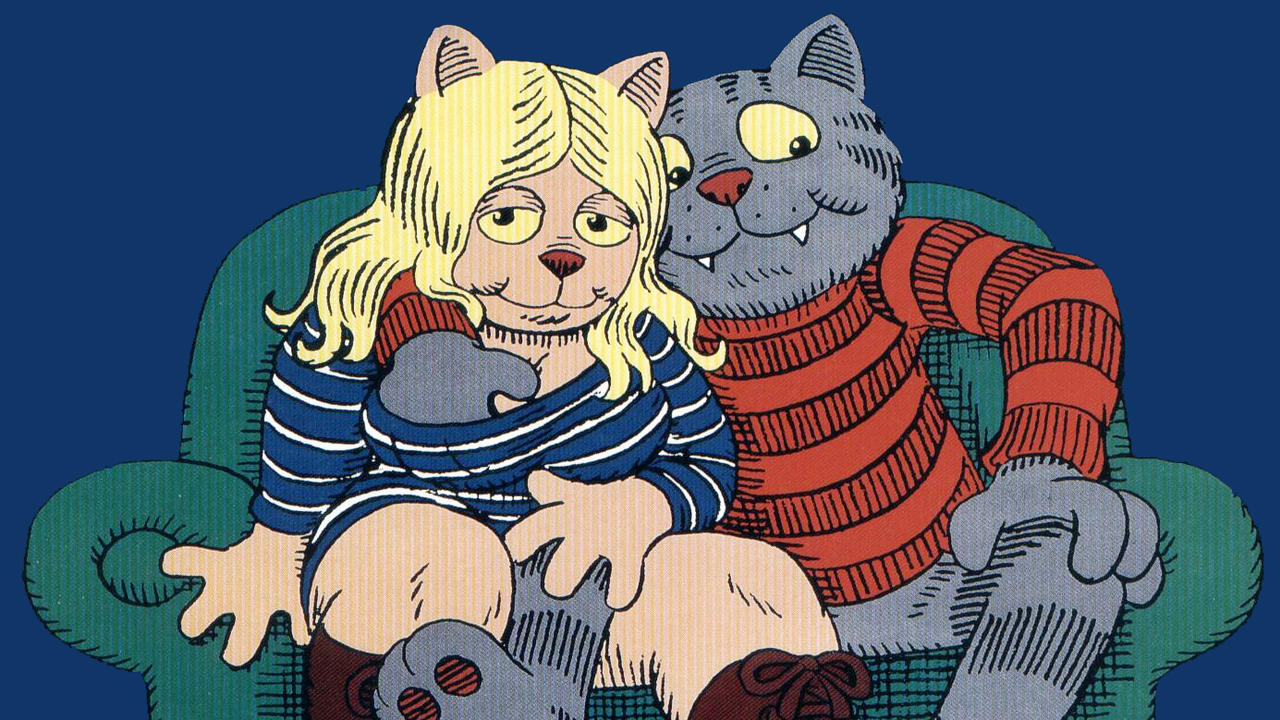 “Furry Chic” is my way of harkening back (tastefully or not) to 1970’s “Porno Chic”. Movies like Deep Throat earned unprecedented mainstream notice and box office success. Film critics and academics love that topic. It came with the sexual revolution and the phenomenon of exploitation movies tackling topics that Hollywood wouldn’t touch. (Like lurid, but socially pointed funky Blaxploitation). It’s possible to find roots of Furry fandom in that milieu… with the first X-rated animated movie, Fritz The Cat.
“Furry Chic” is my way of harkening back (tastefully or not) to 1970’s “Porno Chic”. Movies like Deep Throat earned unprecedented mainstream notice and box office success. Film critics and academics love that topic. It came with the sexual revolution and the phenomenon of exploitation movies tackling topics that Hollywood wouldn’t touch. (Like lurid, but socially pointed funky Blaxploitation). It’s possible to find roots of Furry fandom in that milieu… with the first X-rated animated movie, Fritz The Cat.
Funny how a Zootopia director was quoted as saying this movie will have Disney’s first ‘nude scene.’
Clunk Mag: an interview with a furry.
A conversation with Lilka. “Of all the subcultures that the internet exposed in the new millennium, from all the hundreds of varieties that all rampantly fractured into thousands of niches, there is one that still has the ability to shock: The Furries.” The writer goes out of his way to highlight sexual comments that are not-so-shocking. (And why is he so interested?)
______________
AMAZING FURRY NEWS COMING SOON – You Won’t Believe How The Con Got Embarrassed In #7!
______________
Fursuit 'Doggy Bathtime' Voted Hottest Fantasy That Adult Movies Are Afraid To Do
— Dogpatch Press (@DogpatchPress) September 21, 2015Pittsburgh Says Fuck It And Changes Name To Anthroburgh
— Dogpatch Press (@DogpatchPress) September 22, 2015Huge Drop In Suicides When Police Bring Fursuiters To Hug People On The Edge
— Dogpatch Press (@DogpatchPress) September 22, 2015Fur Con Reminds Guests That Febreze Is Not As Good As A Shower
— Dogpatch Press (@DogpatchPress) September 22, 2015Hotel Guest Trapped In Elevator With Furries Comes Out With Huge Grin, New Fursona
— Dogpatch Press (@DogpatchPress) September 22, 2015Study Reveals Furry Yiffing Can Generate Enough Static Electricity To Solve World Energy Crisis
— Dogpatch Press (@DogpatchPress) September 23, 2015The Necromouser and Other Magical Cats, by Mary E. Lowd – Book Review By Fred Patten
Submitted by Fred Patten, Furry’s favorite historian and reviewer.
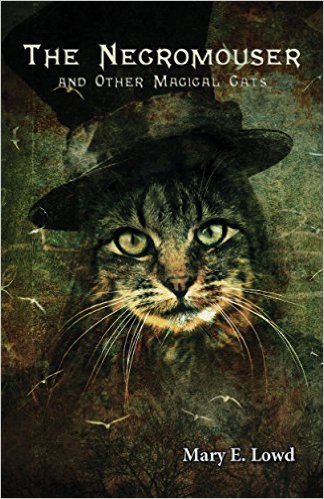 The Necromouser and Other Magical Cats, by Mary E. Lowd.
The Necromouser and Other Magical Cats, by Mary E. Lowd.
Dallas, TX, FurPlanet Productions, September 2015, trade paperback $9.95 (131 pages), Kindle $6.99.
This collection of 13 cat short stories by Mary E. Lowd contains nine reprints and four original tales. It also contains all of her popular “Shreddy” stories, including a new one written just for this collection; six in all.
Shreddy is an overweight tabby housecat; one of three pets – the other two are Cooper, a moronic labradoodle, and Susie, an idiotic spaniel — of a Red-Haired Woman enamored of electrical devices that she doesn’t really understand. Shreddy would undoubtedly take exception to being called a “pet”. He is an independent individual who just happens to share a house with her and her brain-dead, slobbery dogs. He is constantly in a battle of wits with the Red-Haired Woman (which she doesn’t notice), using her electrical devices (that he doesn’t understand, either). Whether Shreddy is using the Red-Haired Woman’s printer to reanimate dead mice (“The Necromouser”), using her smartphone’s games to bring deceased mice (“‘Brains!’ they all squeaked back in chorus”) and neighborhood dogs back from the dead as zombies (“Shreddy and the Zomb-Dogs”), using a TV dish to hatch a griffin’s egg (“Shreddy and the Silver Egg”), dueling with Whisperquick, the ghost mouse (“Shreddy watched with eyes dilated like a kitten high on catnip, wondering whether the Red-Haired Woman and the dogs could see the ornaments constantly rearranging themselves. Surely the Red-Haired Woman must notice that one of her Santa ornaments was wearing six hats while five others went hatless?”) for control over a plastic-&-metal Christmas tree (“Shreddy and the Christmas Ghost”), inadvertently entering a PlayCube (“Shreddy and the Dancing Dragon”), or coming to an accommodation with a Venus flytrap with a sweet tooth (“Shreddy and the Carnivorous Plant”), Shreddy is always determined to defend his turf, even if it almost kills him.
The six “Shreddy” stories fill slightly over the first half of this collection. The remaining seven, four reprints and three original, all quite short, are stand-alones.
“Songs of Fish and Flowers” tells of Carly, a cat in a house of a witch who also grows enchanted roses. When the witch moves out, Carly and the roses are abandoned. This is a melancholy mood piece.
“Katelynn the Mythic Mouser” is a companion story. Aunt Molly is a modern witch with a garden. When little Jenna stays with her, she learns magic. When Jenna has to return to her mundane parents’ home, she wants to bring Molly’s cat, Katelynn, with her. Magic provides a way.
“The Wharf Cat’s Mermaid” is set on San Francisco’s touristy Fisherman’s Wharf. Mari is a homeless kitten, mewing for food from the Wharf’s stalls. She watches as Buttercup, an adult feral cat, is given a glamour by Elayne the mermaid to pose as human to get her Ghiradelli’s bitter dark chocolate in exchange for fish. Mari offers to do the same, but the glamour makes the kitten seem to be a little human child, too young to be alone. Elayne offers her a different magic …
“Magtwilla and the Mouse” features a mother cat who is bereft of her kittens and finds something else to love.
“Cold Tail and the Eyes” could be a companion piece to the above. Here, Gray Tail is one of the kittens, and he fights being separated from his mother. He fights and fights, and uses up his nine lives. He finally learns to stop fighting.
In “All the Cats of the Rainbow”, Sarah is a lively Persian kitten bought as a birthday present by scientist Aunt Carrie for young Toby. On their way to his birthday party, she stops at her lab to check on an experiment. Sarah falls into it:
“A harmony of meows – higher pitched from Violet, Blue, and Indigo; subtly lower from Red – expressed surprise and confusion. All seven of Sarah looked at each other with wide green eyes, unchanged by the prism. On Green, her eyes and fur matched perfectly, a solid emerald kitten. On Red, her sparkling green eyes framed by ruddy red fur gave her face a Christmas look.” (p. 124)
Toby is delighted to get such a playmate.
“In a Cat’s Eyes” contrasts Jason, an exuberant Collie puppy, and Myra, an aged Siamese cat. Jason has his whole future in front of him. But this is only one of Myra’s many, infinitely varied lives.
This small book (cover by Roberto A. Sanchez) – it would be a short novella if it was a single story – presents one magical cat in six adventures, and seven others having an adventure apiece. Many of them are so short they are little more than mood pieces. But they are all delightful, like a box of rich mixed chocolates. They are probably best taken one or two at a time, and savored – unless you are a glutton for all of them at once.
Mad Dogs and Englishmen, by Paul Magrs – Book Review By Fred Patten.
Submitted by Fred Patten, Furry’s favorite historian and reviewer.
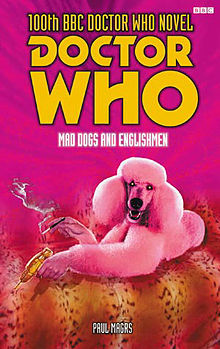 Mad Dogs and Englishmen, by Paul Magrs.
Mad Dogs and Englishmen, by Paul Magrs.
London, BBC Books, January 2002, paperback £5.99 (249 pages).
Doctor Who is massively popular, but his adventures do not seem to offer much for furry fandom. But they do overlap in “The 100th Novel in the Record-Breaking BBC Worldwide Doctor Who Series”, to quote the back-cover blurb. Mad Dogs and Englishmen features the Eighth Doctor (Paul McGann, 1996-2005) and his Companions at the time, Fitz Kreiner and Anji Kapoor. The novel is also a parody of J. R. R. Tolkien’s writing of The Lord of the Rings.
The first chapter is about Professor Reginald Tyler, a reclusive British university don who spends his life from 1917 to his death in 1974 writing and rewriting his magnum opus The True History of Planets, “an epic of dwarves and swords and wizardry. And definitely no poodles. Or at least there weren’t when the Doctor read it.” (blurb) When Prof. Tyler dies, his widow takes his towering manuscript to a publisher.
“She was the one who had hoiked out the dusty manuscript of the ongoing book and promptly sold it for a bomb.
One that set off reverberations everywhere.
Up and down the length of the twentieth and twenty-first centuries on Earth, and other worlds besides.
Notably the dogworld.” (p. 3)
Chapter Two begins, “In another hotel, one hundred years later and off-world, a conference was underway.
The hotel was built into a small, rather tatty-looking asteroid and it was, for one weekend, playing host to an academic conference and a motley collection of academics, all of them concerned with Terran Science Fiction of the Twentieth Century.” (p. 9)
One of the attendees is Professor Alid Jag, a tiny but loud literary critic from a people that “were tantamount to aphids” (p. 10). He believes that, “You have to learn to despise what you analyse” (p. 11) to be a proper critic. Prof. Jag is pontificating in the hotel’s foyer when the TARDIS materializes on top of him, crushing him. The Doctor has arrived to hear Prof. Jag’s paper, and is nonplussed to learn that he is responsible for the crypto-aphid’s death. He and his Companions, Fitz and Anji, are taken in charge by the hotel’s manager – “The manager was a boar, standing erect on his two hind legs and wearing a smart uniform adorned with all manner of medals. His humped back stood almost as tall as the TARDIS itself and his rancid breath came steaming out through a snout that quivered and dripped in annoyance.” (p. 16) – while waiting for the police to arrive.
Chapter Three reveals what really happens to Prof. Tyler when everyone thinks that he died. He was abducted into an alternate timeline by a bright blue anthropomorphic French poodle.
It turns out that Prof. Jag was more sinister than he seemed. He was trying to murder an expert on Reginald Tyler. When the expert is murdered, after all – after Prof. Jag’s death – the Doctor, Fitz, and Anji are blamed for it. Meanwhile, the Doctor has discovered that The True History of Planets is no longer about dwarves and swords and wizardry.
“‘Poodles,’ said the Doctor.
‘That’s them.’
Anji raised both eyebrows.
‘With hands!’ Fitz laughed. ‘In the book, they live on this planet where they’ve clambered their way to the top of the evolutionary ladder with their perfectly manicured five-fingered hands and by making full use of their opposable thumbs. They have a very luxurious world with a corrupt monarchy and the book’s all about their various skirmishes and how one of them manages to depose the queen of the dogworld and set himself upon the throne…’” (p. 34)
Well, obviously there’s nothing for it but to be off to the dog dimension. With Flossie, the asteroid hotel’s disgraced cook:
“‘I fell from grace during the greatest of my challenges and honours. Oh my, but I did. Oh yes. That was a terrible story. It was a banquet for the Child Emperor of Karim. They’re a kind of… well, there’s no nice way of putting it. Lobster people. It was all some kind of peace treaty thing going on. Well, no one told me they were like lobster people. And you can guess what I’d spent all night preparing for their main course…’” (p. 50)
On the dogs’ space station:
“Look at those pictures!’ the Doctor called out.
Each one showed a dog staring straight out at the onlooker, baring its fangs. They were beribboned and titivated. Some of them were wearing elaborate bonnets.
Fitz burst out laughing and the Doctor shushed him.
‘These,’ he said sternly, ‘are probably the great and good of this civilization.’
‘It’s like an Intergalactic Crufts,’ Anji said. ‘Or like some mad version of Planet of the Apes. .. with, um, poodles instead of monkeys…’” (p. 63)
The humans are present at the beginning of the dogs’ civil war:
“‘Grrr,’ said the guards. It was their ceremonial greeting.
‘Grrr,’ said the archivists dutifully. Having been here for so long, they were unused to such formalities. The lack of ritual arse-sniffing was a definite snub. Fritter and Char were evidently inferiors, and not to be sniffed. Char felt this like a slap in the face.” (p. 65)
The Doctor, Fitz, and Anji, who have all their clothes confiscated while on the dogs’ space station, re-dress and escape into time-travel: Fitz and Flossie to Las Vegas in 1960; Anji and Fritter (disguised as an ordinary dog) to Hollywood in 1978; and the Doctor and Char to 1942 Bournemouth where they must prevent Prof. Tyler from being influenced into throwing out his manuscript about dwarves, swords, and wizardly and writing about a world of poodles instead. Fitz and Flossie encounter an entertainer singing the Beatles’ songs before they’ve written them; Anji and Fritter encounter an obvious pastiche of Ray Harryhausen; and the Doctor and Char find Prof. Tyler at his literary club, the Scribblings, arguing with his friend Cleavis who tries to persuade him to finish his book and publish it. (Nudge, nudge, wink, wink.)
“Six Imperial poodles, armed and dyed red, had emerged from the copter. They gave the ceremonial greeting as one.
‘Grrr.’” (p. 181)
The poodles of the monarchy are dyed bright scarlet. The rebel poodles are dyed bright orange, green, purple, and other colors. There is a battle between stop-motion monsters and CGI monsters. There are the Mob, dozens of Nöel Cowards, and MIAOW. And more.
The TV program doesn’t have the special-effects budget for stuff like this. This paperback does. Mad Dogs and Englishmen is over a decade old, but it’s still available through Amazon.uk. Have fun.
The cover is only credited to Blacksheep Design Ltd., a London art agency. What appears as bright yellow lettering in its illustration is in gold foil on the book (which unfortunately doesn’t photograph well).
The Cat, by Pat Gray – Book Review By Fred Patten.
Submitted by Fred Patten, Furry’s favorite historian and reviewer.
“Here is another of my reviews that was published ten years ago, edited in a manner that I didn’t like. This is my original review, so it’s a bit different from the printed version.”
 The Cat, by Pat Gray.
The Cat, by Pat Gray.
Sawtry, Cambridgeshire, UK, Dedalus Ltd., March 1997, trade paperback £6.99 (124 pages).
U.S. edition: Hopewell, NJ, The Ecco Press, November 1998, hardcover $19.00 (124 + 1 pages).
“A dark comedy with universal appeal, The Cat is the Animal Farm of the post-communist 1990s,” says the American dust-jacket blurb, while a Scottish review of the original British edition says that, “Gray’s reworking of the Animal Farm concept brings in a post-Thatcherite twist.” Animal Farm may live forever, but is The Cat really a modernization of Animal Farm for Britain of the 1990s?
“Chez Maupassant” is the typical British suburban home of the Professor and Mrs. Professor, their pet the Cat, and the presumably unnoticed Rat and Mouse. All live very comfortably, since the Professor is a gluttonous slob who leaves rich food everywhere.
“The cheesecake seemed to glow, luminous and fantastic, as the Professor skillfully slid it off its plate and cradled it in his large hand to prevent it breaking apart as his mouth closed in upon it. A look of childish pleasure crossed the Professor’s face, then a look of guilt, then he rammed the entire cheesecake into his mouth and began to eat.” (pg. 11)
The pampered Cat, the brash Rat, and the peevishly ineffectual Mouse (the latter two living under the house or within its walls) are best friends. Unfortunately, the Professor dies of a coronary three pages into the story (though leaving the fridge open). The animals are mildly distressed, but see no reason to fear a change in their lavish lifestyle — until Mrs. Professor moves to Brighton, leaving the Cat behind.
“‘Moved out, eh!’ said the Rat, drying his paws, and replacing the towel in its pouch. ‘Lock, stock and biscuit barrel. Just like that. I knew she would. Cat! What are you doing here anyway? Mouse said you were in Brighton.’
The Mouse saw the Rat appraise the Cat’s downtrodden air in one swift glance, and saw him note the slight dusty pallor that now clung to the Cat’s normally glistening coat.
‘Cat’s been told he’s got to f…f…f…end for himself,’ said the Mouse significantly, regaining his voice.
‘Fend for myself,’ repeated the Cat. His eyes were veiled and hurt. ‘I mean I don’t know on what.’ The Cat shrugged expressively at the spot where the fridge had stood, its position marked by an oblong scatter of sticky crumbs and bright-coloured linoleum.” (pg. 36)
As the animals realize that they must fend for themselves, their friendship is strained by basic instincts:
“Some memory of upbringing stirred in the Cat’s mind: rats were dirty, rats were diseased. Although the Rat wore a waistcoat, the Cat believed he could still smell the drain and the outfall. The Cat began to wash himself very slowly. The wind strengthened, whistling in the silent telephone lines that reached from beneath the eaves of ‘Chez Maupassant’, making them sing.
‘Now see here Cat,’ began the Rat, edging himself closer, his tail nonchalantly laid out behind him in a perfect, motionless line.
‘I don’t have to talk to you,’ said the Cat jumpily. The nerves in his forepaws twitched uneasily, making the fur flex as if a fist were being clenched inside a warm winter mitten.
‘We need an understanding,’ said the Rat.” (pgs. 28-29)
The three tacitly agree on a personal nonaggression pact. Instead, each tries to win the support of the animals in the nearby houses and fields. The Cat appeals to their self-interest in a Capitalistic manner, selling them individual portions of ‘Chez Maupassant’’s garden (which he has no rights to), while the Rat (with the intellectual Mouse in tow) harangues them about animal solidarity like a Labour leader:
“The Mouse busied himself setting up a small card table while the Rat paced to and fro, folding the notes for his speech into various shapes […]
‘There’s a few of them here, at least,’ said the Mouse. The animals stood, stamping their feet, and coughing in the cold; a few Moles, a gang of field-voles, the Mouse family from the house next door, and some creatures from the meadow beyond the fence that the Mouse took for squirrels.” (pg. 47)
The Cat decides that since humans have all the benefits, he will impersonate them. He learns to speak English by imitating radio broadcasts, and charms Mrs. Digby, the next-door neighbour. He orders new furnishings for ‘Chez Maupassant’ over the telephone using the Professor’s credit card:
“‘Where’s he getting it all from?’ whispered the Mouse.
‘This is fraud. Classic short-termism. It won’t last. We’ll be back to square one in no time at all,’ said the Rat grimly, his eyes following each new item as it appeared, and was tallied by the Cat (who would remark from time to time that this or that item might have been slightly marked in transit, or be worth a few bob, or perhaps be needed in a different shade of beige or pink.)” (pg. 84)
But it does last. Eventually the Cat carries his faux humanism too far, trying to drive a car and getting smashed up. The book ends with the Cat having returned to cattitude as Mrs. Digby’s pampered pet, while the Rat with the Mouse as his secretary take over running the run-down, unsaleable ‘Chez Maupassant’:
“The Rat yawned. The Mouse poked the fire by his feet. The Rat sighed. It had been another very tiring day, he thought. The Rat sighed again. As time went on, he was finding the administration of the garden harder; the constant rows and arguments which seemed to erupt about the exact needs of field voles, or the special requirements of pregnant moles, arguments which were not only dull, but exhausting to resolve. He would try to make fair decisions, but everyone would complain, and then he would change his mind, and then …” (pg. 123)
A British Animal Farm for the 1990s? Well, the easy life under the Professor can be taken as the strong economy of the 1980s under Margaret Thatcher’s Conservative government. But Thatcher was succeeded in 1990 by John Major, also a Conservative, until 1997, the year that The Cat was published. The economy may have gradually declined, but there was no big disaster that caused a dramatic capitalist/labour split. So where is the Orwellian parallel? In any case, The Cat is undeniably a sophisticated talking-animal fantasy, and an exceedingly British one, at that.
Koa of the Drowned Kingdom, by Ryan Campbell – Book Review By Fred Patten.
Submitted by Fred Patten, Furry’s favorite historian and reviewer.
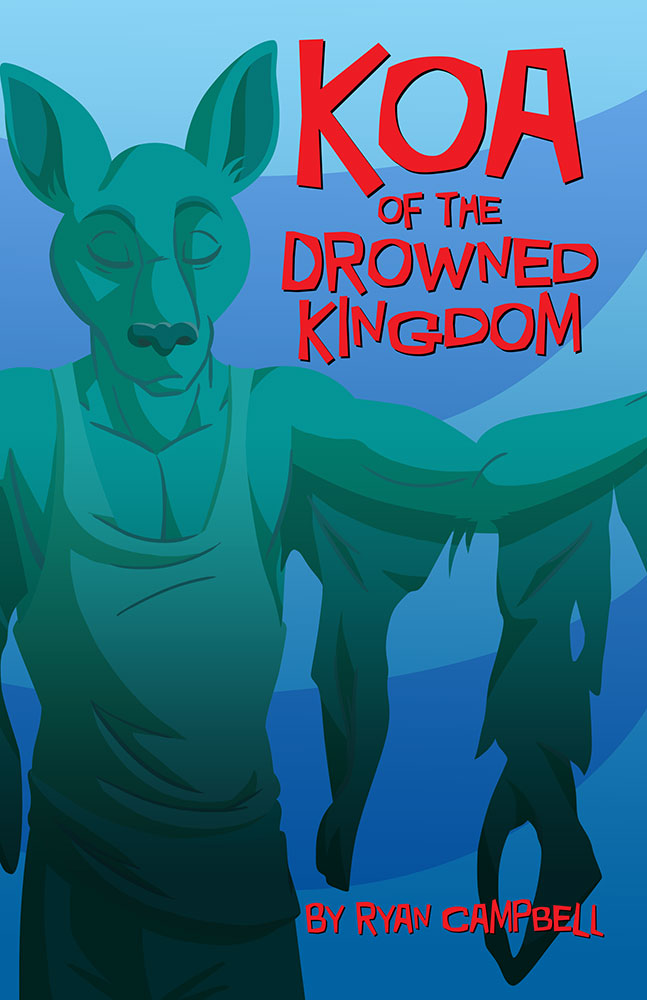 Koa of the Drowned Kingdom, by Ryan Campbell. Illustrated by Cooner.
Koa of the Drowned Kingdom, by Ryan Campbell. Illustrated by Cooner.
Dallas, TX, FurPlanet Productions, September 2015, trade paperback $9.95 (146 pages), electronic edition $6.99.
Koa of the Drowned Kingdom is the tenth of FurPlanet’s “cupcakes”; novellas instead of novels. It seems at one point to be a variant of the Cinderella legend, but that’s misleading.
The setting can be taken variously as another world, as completely imaginary with funny animals, or somewhere in Melanesia in the far future. It’s a civilization of giant mangrove trees rising out of the Southern Sea, inhabited by anthropomorphic fruit bats (flying foxes), otters, wallabies, and monitor lizards. (No other Melanesian fauna like rhinoceroses or monkeys, though.) Their money is the rupiah, the real life currency of Indonesia. Magic is real, though officially only practiced by the bats.
The society is developed in rich detail. Each mangrove tree is a huge separate Kingdom with homes and shops upon its branches, with the trees all locked together by rope bridges and boat travel at the bottom. Each giant tree is divided into habitats ranging from the Crown at the top, down through the Head, the Shoulders, the Belly, the Knees, and the Toes at the bottom which are the mangrove’s roots rising above and sinking beneath the ocean. The trees’ branches are Arms. The habitats are also divided socially, with the Crown inhabited by the flying fox aristocracy who set great prestige on their ability to fly, down through the Shoulders relegated to the upper classes, the Belly to the merchants, and the Knees to the lowest class, the otters who are fishermen. Nobody lives on the Toes, which dip into and out of the ocean. Different Kingdoms are the Kingdom of Titan, the largest tree; the Kingdom of Beards, whose branches are covered in beardlike moss; the Kingdom of the Great Drinker, a bulbous hollow mangrove with a large pool of drinkable water collected from rain and dew in its belly; and others – including the Drowned Kingdom, Atlas, once the mightiest of all until it was uprooted by the Great Storm and toppled beneath the Southern Sea. Kingdom can also refer to the social strata, with the Crown as the elite of the Upper Kingdoms and the Knees as the least desirable of the Lower Kingdoms. The division is not just social; the flying foxes use magic to keep other animals out of the Crown and Head Kingdoms.
Koa is a young flying fox trapped in the Knees of Titan. He cannot fly. He was orphaned and his wings shredded beyond repair in the Great Storm that destroyed his Kingdom of Atlas. The shredding of his wing membranes has made him hideously disfigured and an outcast to the other flying foxes. He was adopted by a gregarious otter family living in Titan, and he has grown up with eight foster brothers and four foster sisters. His best friend is his brother Tug. Besides fishing, Koa and Tug spend their time scouring the muddy shallow seabed beneath Titan for whatever has been dropped or thrown away by the flying foxes living in the Crown – it may still be worthwhile to the bottom-class otters.
Koa has reached the age when he is beginning to develop amorous urges, but to other flying foxes, not otters. Specifically to Maiel, the son of a wizard aristocrat in the Crown of Titan. But they almost never meet socially since Maiel seldom comes down below Titan’s Head, and Koa is too embarrassed by his torn wings to venture into the bats’ world; especially since haughty Hayden makes a point of publicly humiliating him when he does.
When Ruduuk, a monitor lizard merchant, offers him a temporary glamour (good only until midnight) so he can appear as a handsome, aristocratic flying fox and attend the exclusive Firefly Ball in the Crown to meet Maiel, this is when Koa of the Drowned Kingdom seems to turn into a disguised Cinderella. Don’t You Believe It! There is treachery, surprises, danger, fights to the death – well, you don’t want a spoiler. Just read it. You won’t be disappointed.
Campbell writes excellent prose. Here is the general setting:
“The rope ladder to which he [Koa] clung shook, and he gripped it more tightly with his toes. Above him, thousands of feet tall, the mighty mangrove swayed in the ocean breeze. This was Titan, and of all the Kingdoms, it was easily the largest and mightiest. But because of its massive size, the tree caught more of the wind, and was always in motion, bowing and dancing before the endless expanse of the Southern Sea. Looking up, Koa could see its powerful arms stretching out over the water, heavy with green leaves and ripening fruit, lights twinkling in the settlements on the eastern bough where night’s shadow already fell. Still higher, he could make out the Crown of Titan, where all the flying foxes lived. All but him. (p. 7)
Here is what Koa finds in the Crown of the Kingdom of the Beards:
“Beauty and wealth met his eyes. The branches of the great tree twined everywhere, shaped by magicians into pathways and winding pillars lined with flowers and heavy fruit. Glowlamps dangled upward from the floor on long, swaying vines that could be reeled down to illuminate something close by in light of any color. Ladders and woven staircases linked floor and ceiling to dizzying effect, with flying foxes strolling about hanging from their feet, or standing on the ceiling above with equal ease. Koa’s head whirled; it was difficult to remember which direction was which. He plucked a leaf from a nearby branch and let it go, watching it twirl and dive to the ceiling above, where others of his kind played and talked. He could understand why so many objects were lost, dropped into the Nets above.” (p. 62)
Although there are some scenes of M/M romance, they are very chaste. The book’s cover is by Cooner, who also has five full-page illustrations in it. They are accurate but very cartoony. I think that more realistic art would have improved the story; though as cartoons, these are fine.
The Wind in the Willows, by Kenneth Grahame – Book Review By Fred Patten.
Submitted by Fred Patten, Furry’s favorite historian and reviewer.
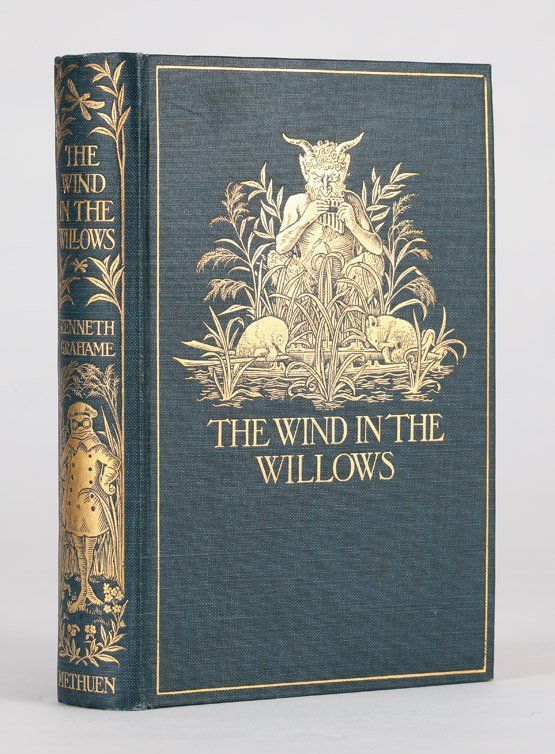 The Wind in the Willows, by Kenneth Grahame. Frontispiece by Graham Robertson.
The Wind in the Willows, by Kenneth Grahame. Frontispiece by Graham Robertson.
London, Methuen & Company, October 1908, hardcover 6/- ([vi] + 302 + [ii] pages).
The Wind in the Willows is world-famous today. It was almost immediately world-famous. President Theodore Roosevelt praised it in 1909. Yet until Grahame died in 1932, he did not think that the entire book could be illustrated. The sole illustrations published during Grahame’s lifetime were of the famous “The Piper at the Gates of Dawn” chapter featuring the god Pan. Paul Bramson illustrated the 1913 edition showing Rat and Mole gazing at Pan as natural unclothed small animals, even though they get to him by rowboat and by implication have been of human size and wearing clothes just before that. Ernest Shepard’s illustrations in 1933, Arthur Rackham’s in 1940, and the Walt Disney animated feature The Adventures of Ichabod and Mr. Toad in 1949 made it “illustratable” – but usually by omitting the Pan scene.
The reason is because the narrative segues so often between Mole, Rat, Otter, Badger, the weasels and field-mice and hedgehogs and rabbits as natural English riverbank and woodland animals, and their being imitation humans – not just Toad in stately Toad Hall, but each having a small, furnished home – sometimes tiny, sometimes of human size; rowing a boat, presumably wearing clothes (Toad certainly wears clothes and is of human size when he disguises himself as a washerwoman, yet is of toad size when he enters Rat’s riverbank hole), capable of driving a motor-car and of being tried in court. Everyone was aware of the disparity, but because Grahame’s writing was so lyrical, everyone was willing to gloss over the disparity.
Natural woodland animals? The book begins with a blending of the animal and human worlds:
“The Mole had been working very hard all the morning, spring-cleaning his little home. First with brooms, then with dusters, then on ladders and steps and chairs, with a brush and a pail of whitewash; till he had dust in his throat and eyes, and splashes of whitewash all over his black fur, and an aching back and weary arms. Spring was moving in the air above and in the earth below and around him, penetrating even his dark and lowly little house with its spirit of divine discontent and longing. It was small wonder, then, that he suddenly flung down his brush on the floor, said ‘Bother!’ and ‘O blow!’ and also ‘Hang spring-cleaning!’ and bolted out of the house without even waiting to put on his coat. Something up above was calling him imperiously, and he made for the steep little tunnel which answered in his case to the gravelled carriage-drive owned by animals whose residences are nearer to the sun and air. So he scraped and scratched and scrabbled and scrooged, and then he scrooged again and scrabbled and scratched and scraped, working busily with his little paws and muttering to himself, ‘Up we go! Up we go!’ till at last, pop! his snout came out into the sunlight, and he found himself rolling in the warm grass of a great meadow.” (pgs. 1-2)
 The Wind in the Willows was a new kind of children’s book, and at first people did not know what to make of it. Lewis Carroll’s two Alice fantasies were set in what was clearly a dreamland, so it seemed natural being bizarre and shifting and, well, dreamlike. Subsequent children’s fantasies such as E. Nesbit’s brought one fantastic talking animal such as a Psammead or a Phoenix into the real world, or sent a realistic human child into a magic world, as L. Frank Baum’s American Dorothy Gale to Oz. But The Wind in the Willows was supposed to take place in the real England, but with the wild animals having little houses and being able to talk, and where the government (at least the police and the courts) treated the animals as people:
The Wind in the Willows was a new kind of children’s book, and at first people did not know what to make of it. Lewis Carroll’s two Alice fantasies were set in what was clearly a dreamland, so it seemed natural being bizarre and shifting and, well, dreamlike. Subsequent children’s fantasies such as E. Nesbit’s brought one fantastic talking animal such as a Psammead or a Phoenix into the real world, or sent a realistic human child into a magic world, as L. Frank Baum’s American Dorothy Gale to Oz. But The Wind in the Willows was supposed to take place in the real England, but with the wild animals having little houses and being able to talk, and where the government (at least the police and the courts) treated the animals as people:
“‘To my mind,’ observed the Chairman of the Bench of Magistrates cheerfully, ‘the only difficulty that presents itself in this otherwise very clear case is, how can we possibly make it sufficiently hot for the incorrigible rogue and hardened ruffian whom we see cowering in the dock before us. Let me see: he has been found guilty, on the clearest evidence, first, of stealing a valuable motor-car; secondly, of driving to the public danger; and, thirdly, of gross impertinence to the rural police. Mr. Clerk, will you tell us, please, what is the very stiffest penalty we can impose for each of these offenses? Without, of course, giving the prisoner the benefit of any doubt, because there isn’t any.’” (pgs. 139-140)
But the public speedily adjusted to this, and ever since, talking animals and humans have very comfortably mixed in children’s fantasy – and, with Orwell’s Animal Farm and Adams’ Watership Down, in adult fantasy as well.
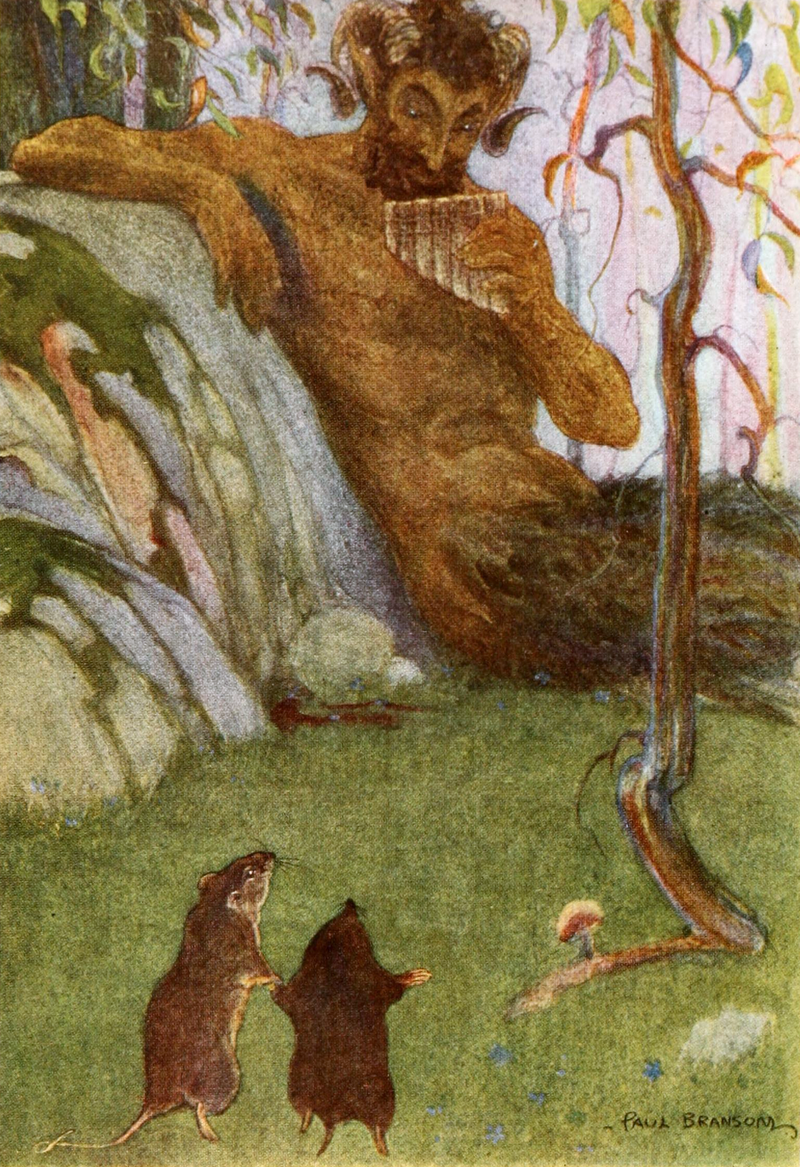
The Wind in the Willows is neatly divided into two parts. The first five chapters paint a lovely, peaceful word-portrait of the wondrous English countryside, and lazing along the river (by implication, all English rivers) during spring, summer, and autumn; but also during the depths of winter:
“The Mole came and crouched beside him [the Rat], and, looking out, saw the wood that had been so dreadful to him in quite a changed aspect. Holes, hollows, pools, pitfalls, and other black menaces to the wayfarer were vanishing fast, and a gleaming carpet of faery was springing up everywhere, that looked too delicate to be trodden upon by rough feet. A fine powder filled the air and caressed the cheek with a tingle in its touch, and the black boles of the trees showed up in a light that seemed to come from below.” (p. 60)
Chapters 6 and 8 through 12 shift to what Disney calls “Mr. Toad’s Wild Ride”: Badger, Rat, and Mole’s attempt to reform Toad by locking him in his bedroom, his escape and stealing a motor-car, his being sentenced to twenty years in a dungeon, his escape disguised as a washerwoman, his dashing recklessly in a railroad locomotive and barge and by horseback and the same motor-car while singing a rollicking boast …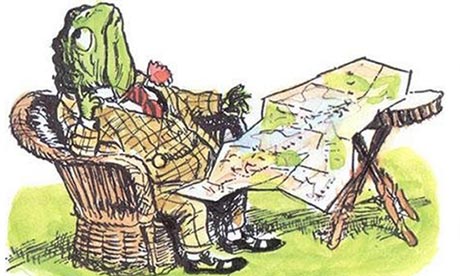
“‘The world has held great Heroes,
As history-books have showed;
But never a name to go down to fame
Compared with that of Toad!’” (p. 236)
… until rescued by Rat, his learning that Toad Hall has been occupied by the Wild Wood weasels and ferrets and stoats during his absence, and Rat, Mole, and Badger’s reconquest of Toad Hall with him. There is a setup for Toad’s adventures in the “peaceful” first half, and Rat’s almost being lyrically seduced into seeking sea wanderings in the “action” last half, and the beautiful but strangely out-of-place Chapter 7, “The Piper at the Gates of Dawn” (it reads like a separate work); and somehow it all seems to fit together. The 1908 idyllic portrait of the unspoiled English countryside has been growing increasingly outdated during the century-and-more since The Wind in the Willows was written, yet its story seems timeless and ever-fresh.
If you have missed the delight of reading The Wind in the Willows, read it now. If you have only seen the 1949 Disney animated cartoon, discover the real book.
